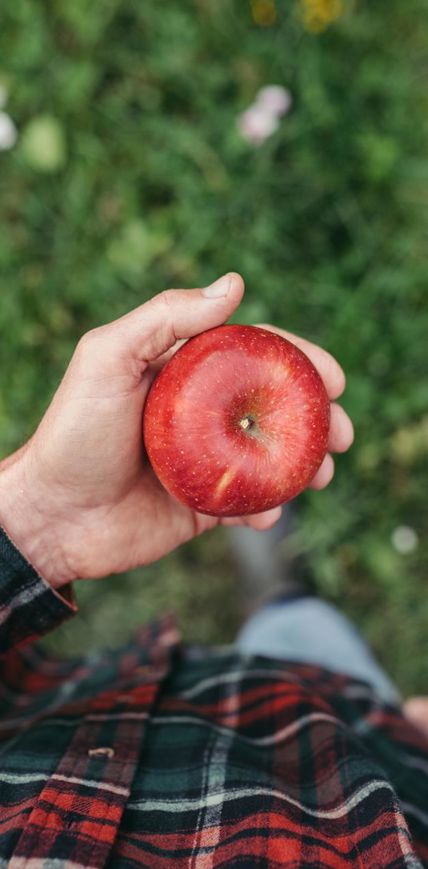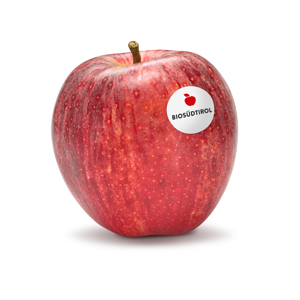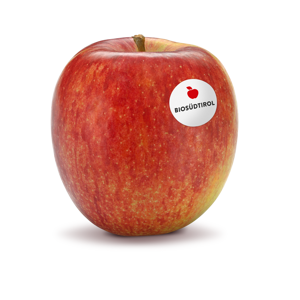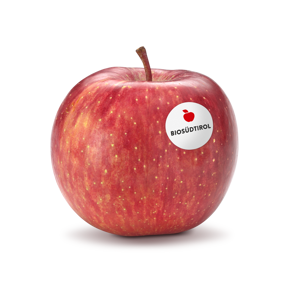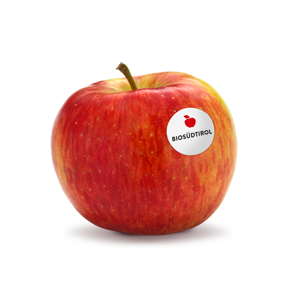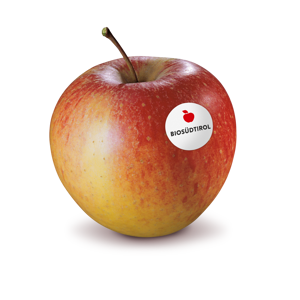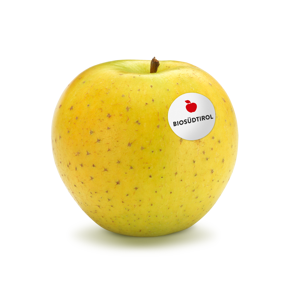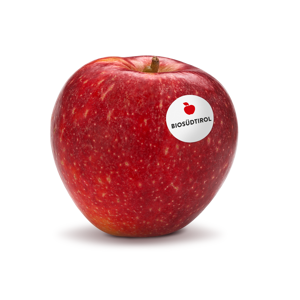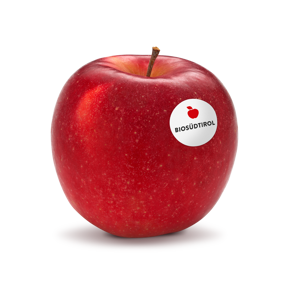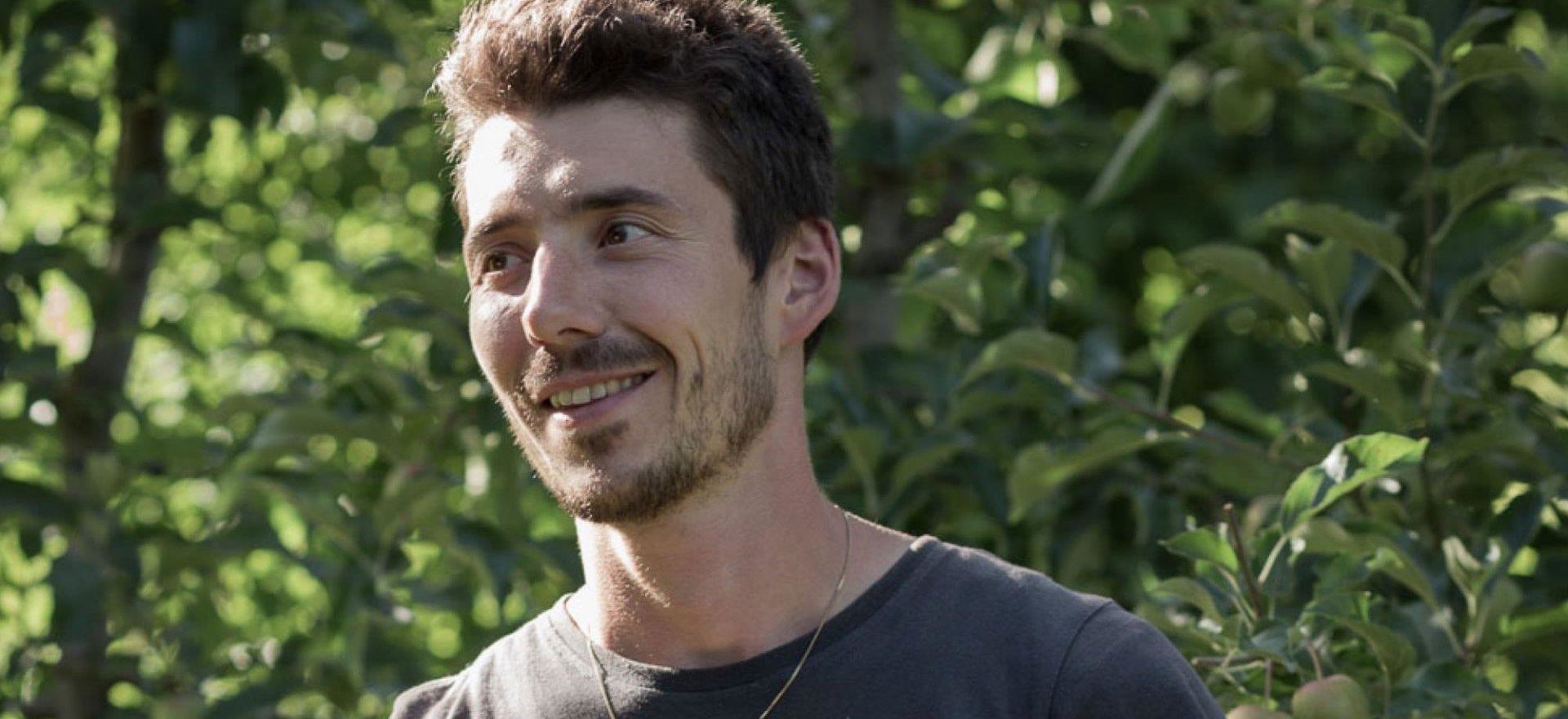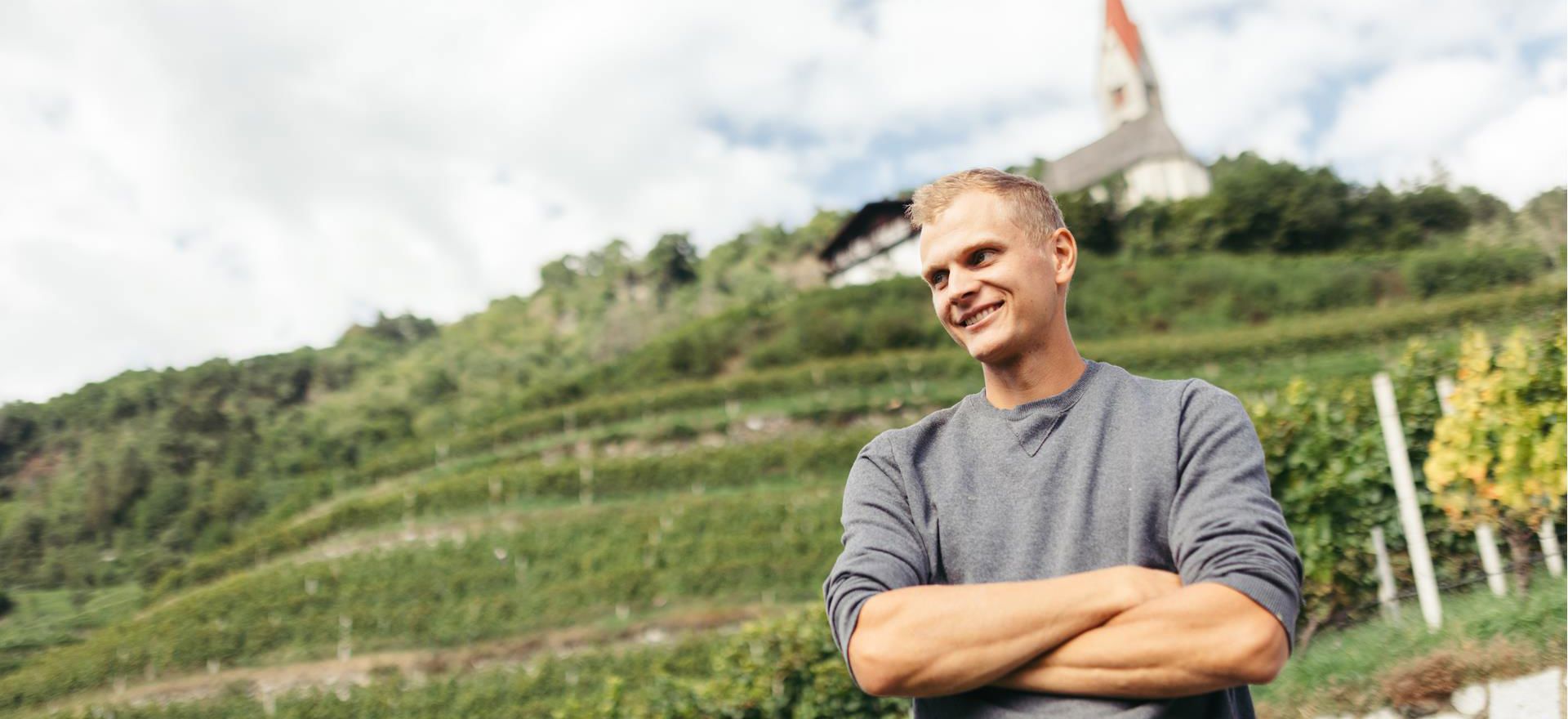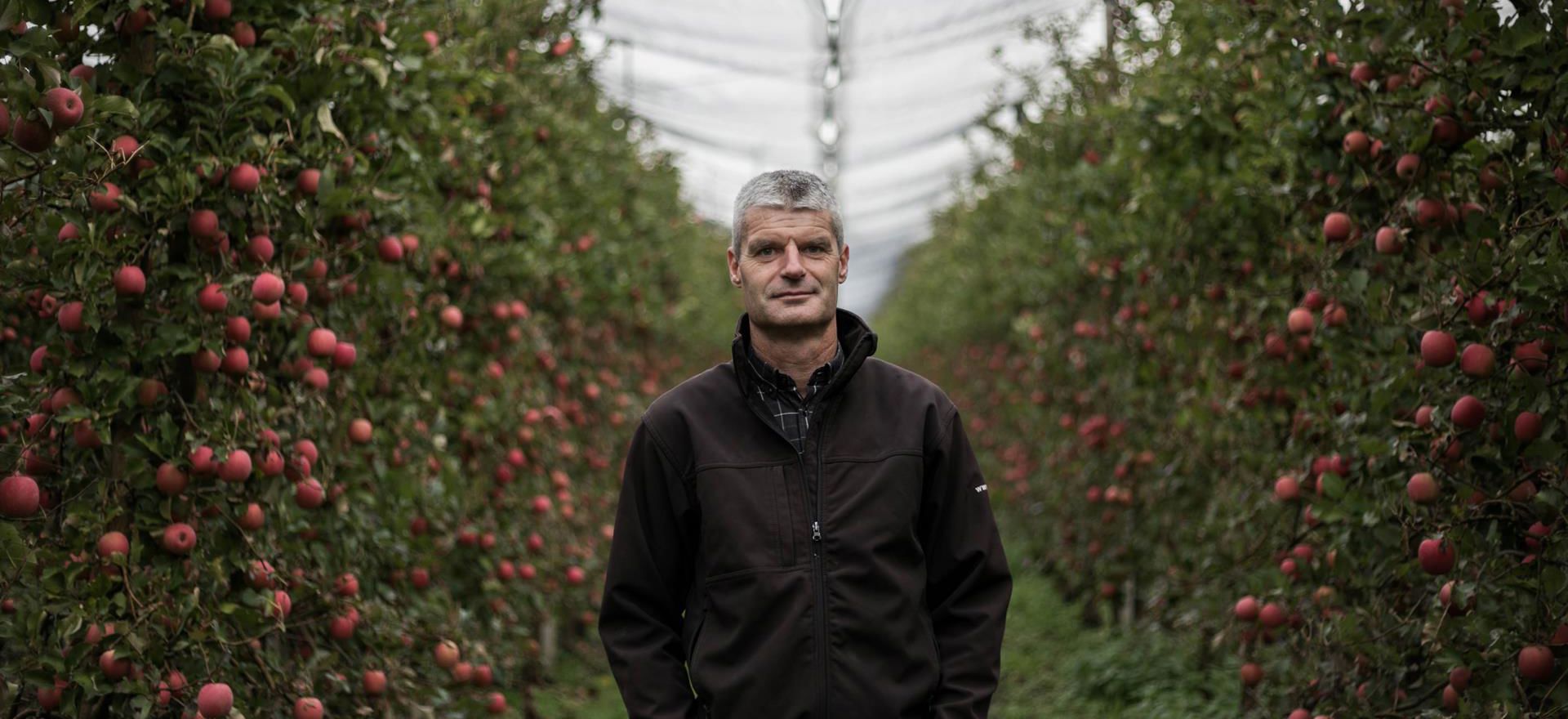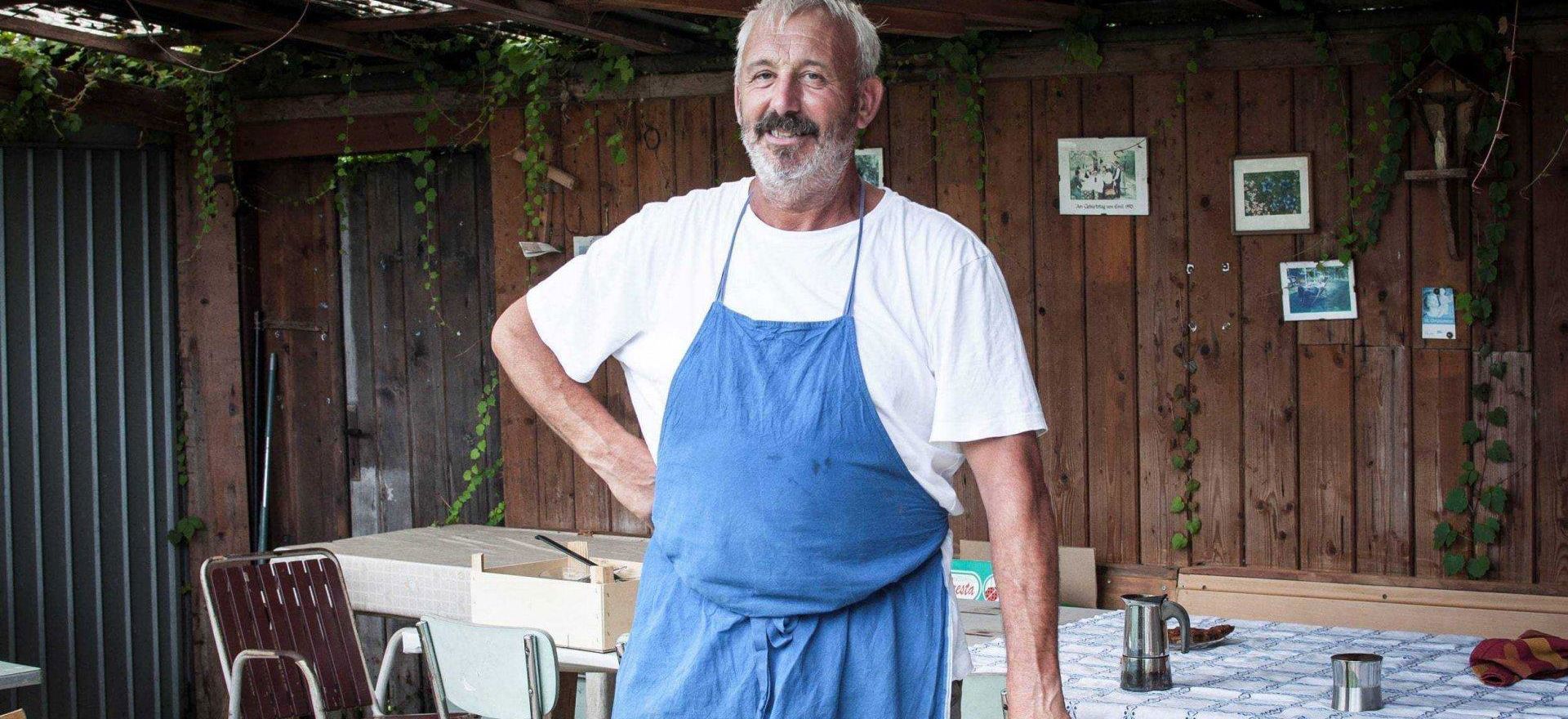Questions and answers
Which apple variety is best for preparing apple strudel?
Which apple variety is best for preparing food when starting to wean infants?
What apples do you use to make Biosüdtirol apple juice?
What gives the apples their typical colours?
Do apples continue to ripen after they’ve been harvested, like bananas, which are often picked while they’re still unripe?
Is it possible to grow organic apples in an apple meadow that is situated next to a conventional apple meadow?
Are the apples sold by Biosüdtirol also grown by Biosüdtirol?
I’ve heard that a hail net will also protect the apples from too much sun. Is that true?
Are plant protection products used in organic farming?
How are apples harvested?
How are organic apples stored in the cooperative?
What happens with the apples that are often only slightly damaged but can’t be sold as whole fruit for eating?
How should I store an apple at home?
Do I have to peel an apple before I eat it?
Organic apples are much more expensive than conventionally grown apples.
Organic apples are much mAre organic apples smaller/less perfect than conventional apples?ore expensive than conventionally grown apples.

Technically, any apple variety works well for the typical South Tyrolean apple strudel – slightly acidic varieties (Topaz, Bonita, Braeburn) provide a more acidic note in the strudel, sweet varieties make the strudel sweeter (Golden Delicious, Fuji, Gala).
Any sweet apple is ideal, for example, Fuji or Golden Delicious, but also Gala. Some nutrition experts recommend Granny Smith as it contains less sugar, others recommend other varieties.
We use the following 3 varieties: Braeburn, Fuji and Pinova.
The colour of the apples depends on the variety. For example, Granny Smith is always green, Golden Delicious is always yellow with slightly red cheeks. The South Tyrol’s unusual climate, with its sunny days and cool nights, also plays an important role in the development of the apples’ colouring.
Apples are harvested when they reach ‘plucking maturity’. That is the optimum point of ripeness for storing, transportation and sale before reaching the consumer at the point of perfect ripeness for eating. However, apples also produce ethylene which means that they continue ripening at home.
It is possible to grow organic apples next to a conventional apple meadow. Regular residue analyses make this possible. Before harvesting, the organic apples growing in the rows of trees on the margins of the meadow are tested for residues. If the tests show positive results for substances that are not permitted in organic cultivation, then these apples are sold as conventional apples.
Each and every apple sold comes from one of the 300 organic farmers who comprise Biosüdtirol.
The main task of the hail net is of course to protect the apples from hail, which can damage them. However, it also protects them from too much sun, which can leave ugly traces. Plus, the net also protects the apples from harmful insects.
Organic farming doesn’t cut out plant protection products completely. However, organic farming employs only nature-identical substances. These are substances that also occur in nature in their pure form.
Apples are picked by hand from the apple trees. Usually the farmer himself takes care of that, with the help of his family and harvest helpers. The harvest period lasts from the end of July to the end of November – depending on the variety of apple.
Apples that have been harvested in the autumn can be treated with a special storage technique and stored until July. This storage method has been used for decades and allows longer storage times. The natural nitrogen content in the air is increased using special equipment, thereby removing oxygen from the rooms. The lower the oxygen level sinks, the more the fruits’ metabolism is slowed. This means the apple breathes more slowly and so the ripening process in the apple also slows down. In this way we can store the apples for a relatively long time.
Those fruits can be used for products such as baby food, apple purée, apple rings, chocolate and apple confectionery, apple juice and even apple leather.
The best thing to do at home is to store them in a cellar at a constant temperature. Alternatively, apples can also be stored in the fridge, but you should take them out a couple of hours before you intend to eat them so that they can be enjoyed at room temperature.
No, not at all. You can eat an apple with its peel – the apple skin contains the majority of the vitamins in the apples. But you should wash apples before you eat them.
Price comparisons between conventionally grown apples and organic apples are heavily dependent on the variety. Some varieties only have a very small price difference in price, but other varieties may be 50% more expensive. The reason for this is the additional costs incurred by the farmers and the higher (and more expensive) standards that must be met in production. In organic farming, the yields per hectare of surface area are about 30% lower than in conventional farming. Moreover, organic cultivation produces a significantly higher share of processing apples – imperfect, slightly damaged fruits are used to make, for example, apple juice. The farmer receives a much lower price for product used for processing.
Organic apples are generally smaller than conventionally grown apples. One reason for that is that, in comparison to conventional farming, only a limited number of methods are available for blossom thinning, which is necessary to ensure a certain size and quality of apple. That makes thinning more difficult and so generally there are more apples left on the tree, which leads to a smaller fruit size. Furthermore, organic farming cannot use any synthetic fertilisers to encourage the fruits to grow artificially. In terms of physiological damage to the apple itself, the situation is similar. Because fewer substances are available to the organic farmer, organic apples are more susceptible and that can result in slight damage to the skin of the fruit.
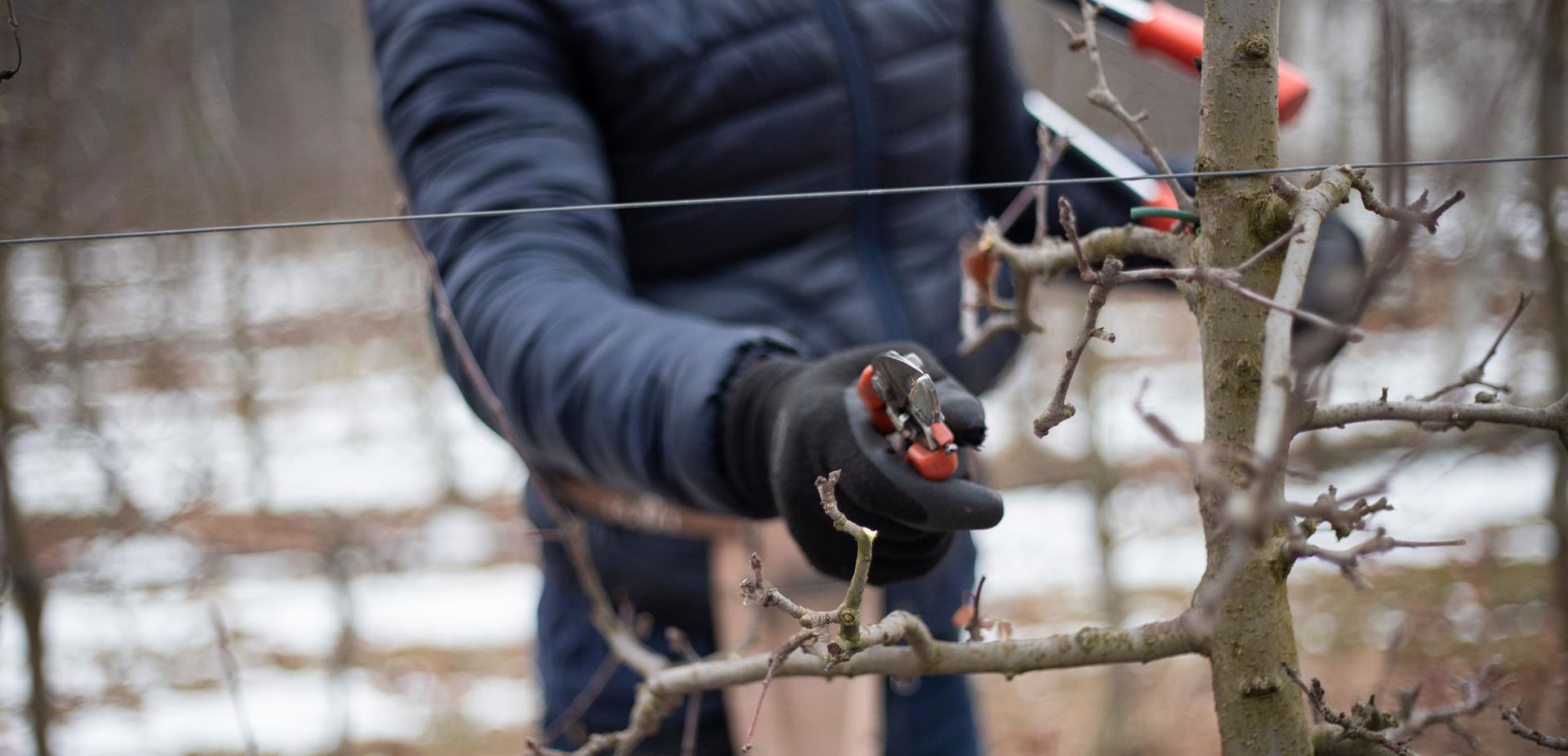
January
Pruning.
Winter wonderland. Snow covers the tramlines in the apple orchards. The air is fresh. The sun is low on the horizon. The mercury is even lower. Quiet buzzing interrupts the silence. The lift makes its way between the row of trees. With concentration and skill, we organic farmers guide the pruning shears around bare branches. Click. Click. Click.
This is how we prepare our apple trees for the next harvest during their dormancy period. The idea is to shape the trees such that the apples receive sufficient sap and light later. The way they are pruned depends on the apple variety. And of course on the farmer’s philosophy.
This is how we prepare our apple trees for the next harvest during their dormancy period. The idea is to shape the trees such that the apples receive sufficient sap and light later. The way they are pruned depends on the apple variety. And of course on the farmer’s philosophy.
Winter wonderland. Snow covers the tramlines in the apple orchards. The air is fresh. The sun is low on the horizon. The mercury is even lower. Quiet buzzing interrupts the silence. The lift makes its way between the row of trees. With concentration and skill, we organic farmers guide the pruning shears around bare branches. Click. Click. Click.
This is how we prepare our apple trees for the next harvest during their dormancy period. The idea is to shape the trees such that the apples receive sufficient sap and light later. The way they are pruned depends on the apple variety. And of course on the farmer’s philosophy.
This is how we prepare our apple trees for the next harvest during their dormancy period. The idea is to shape the trees such that the apples receive sufficient sap and light later. The way they are pruned depends on the apple variety. And of course on the farmer’s philosophy.
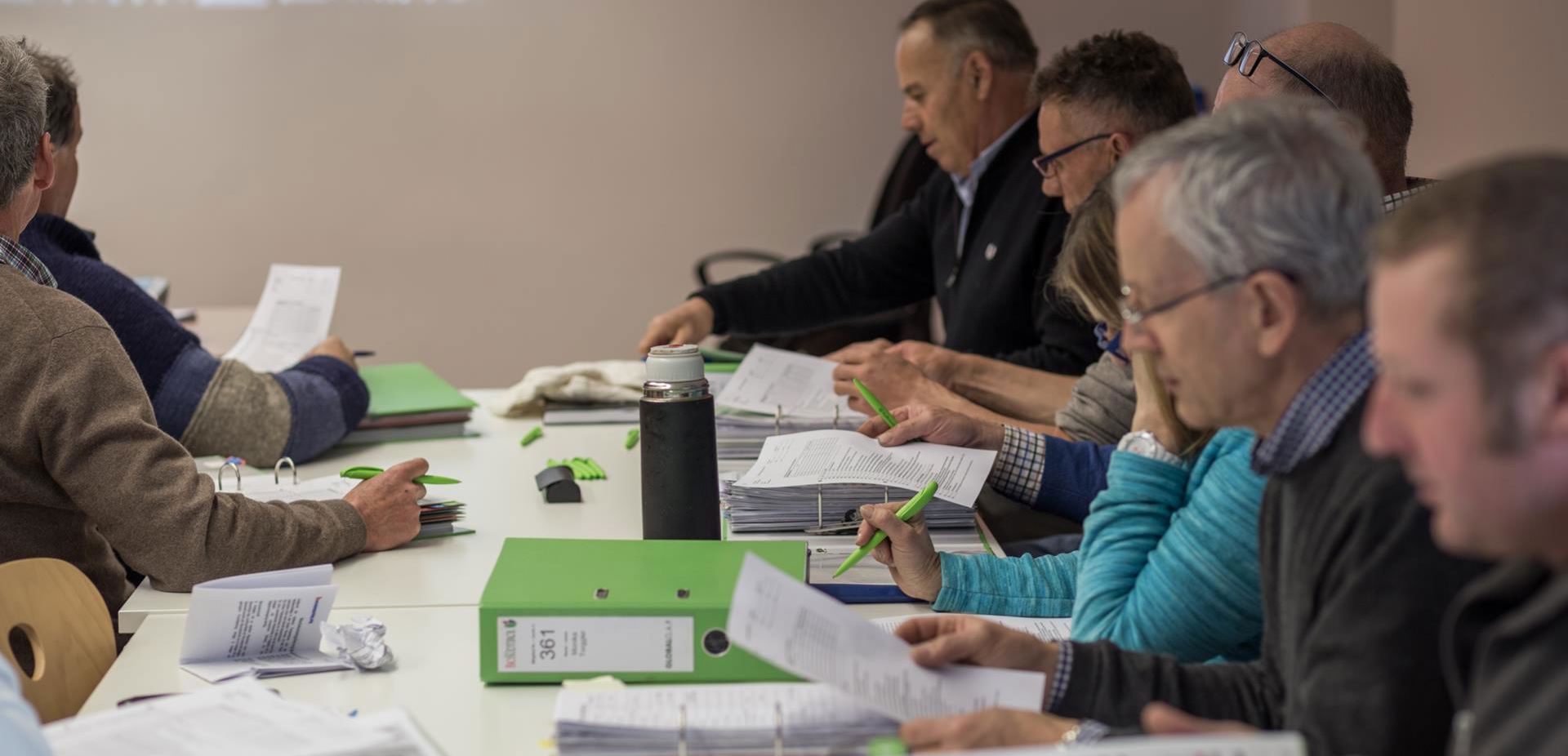
February
Fresh start.
We prune the trees that we have not yet put in to the ideal shape. And we put ourselves into shape as well by means of lively group discussions and advanced training. We attend lectures and seminars on a range of topics that includes everything from occupational safety and hygiene to apple cultivation.
And it’s now time to create a few new apple orchards... in the areas we cleared in the late autumn.
Not an easy task: stretching wire between pillars, inserting watering hoses and fitting crosswise tensioning, for example. And fitting hail nets where they are required. At the end of the month, the sun exerts its power again. During the day, the temperature rises slightly. The sunlight and warmth stimulate new elan in the groves and the first buds start to swell. Spring tests the waters: furtively, without making waves.
And it’s now time to create a few new apple orchards... in the areas we cleared in the late autumn.
Not an easy task: stretching wire between pillars, inserting watering hoses and fitting crosswise tensioning, for example. And fitting hail nets where they are required. At the end of the month, the sun exerts its power again. During the day, the temperature rises slightly. The sunlight and warmth stimulate new elan in the groves and the first buds start to swell. Spring tests the waters: furtively, without making waves.
We prune the trees that we have not yet put in to the ideal shape. And we put ourselves into shape as well by means of lively group discussions and advanced training. We attend lectures and seminars on a range of topics that includes everything from occupational safety and hygiene to apple cultivation.
And it’s now time to create a few new apple orchards... in the areas we cleared in the late autumn.
Not an easy task: stretching wire between pillars, inserting watering hoses and fitting crosswise tensioning, for example. And fitting hail nets where they are required. At the end of the month, the sun exerts its power again. During the day, the temperature rises slightly. The sunlight and warmth stimulate new elan in the groves and the first buds start to swell. Spring tests the waters: furtively, without making waves.
And it’s now time to create a few new apple orchards... in the areas we cleared in the late autumn.
Not an easy task: stretching wire between pillars, inserting watering hoses and fitting crosswise tensioning, for example. And fitting hail nets where they are required. At the end of the month, the sun exerts its power again. During the day, the temperature rises slightly. The sunlight and warmth stimulate new elan in the groves and the first buds start to swell. Spring tests the waters: furtively, without making waves.
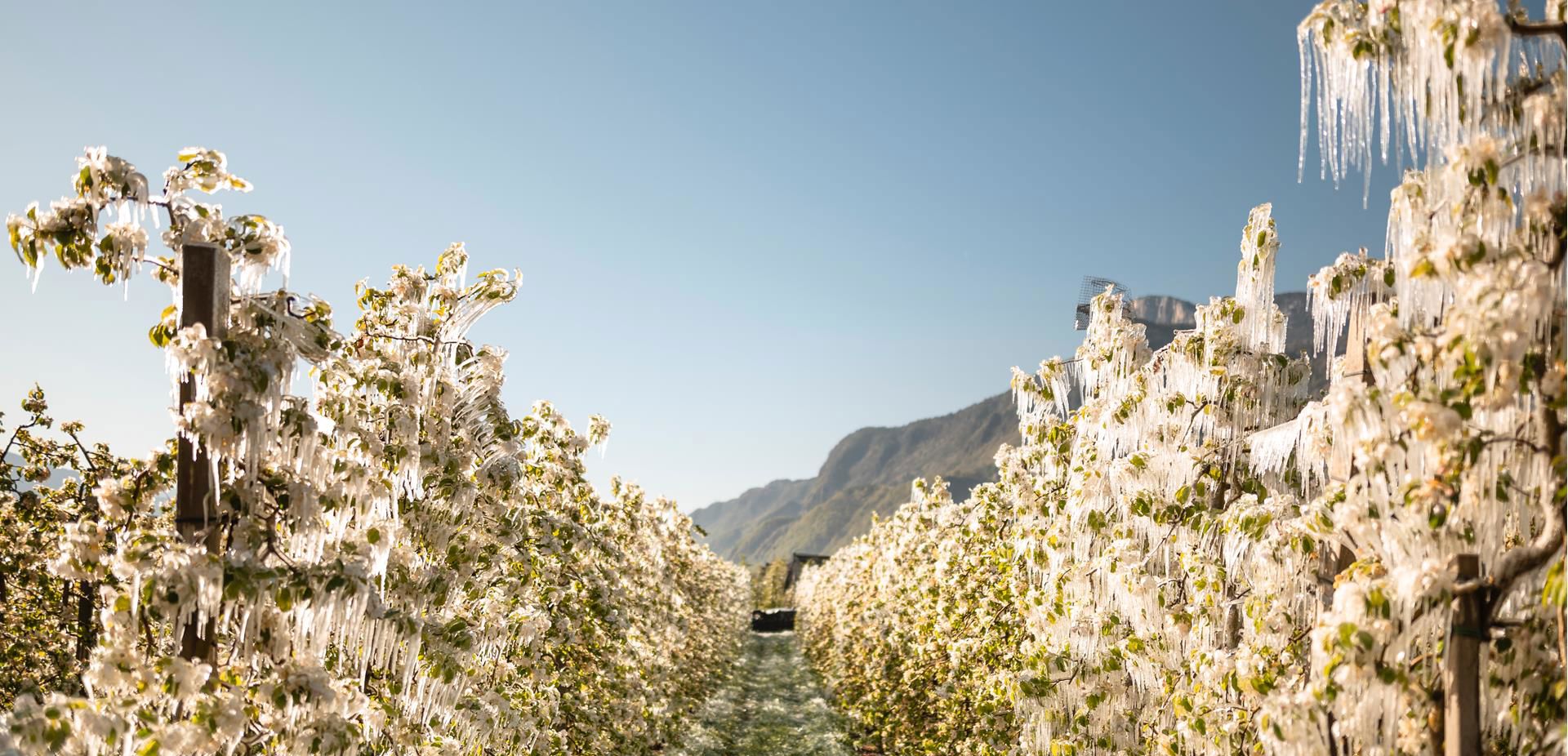
March
Awakening.
Hello spring! Nature gathers momentum and the buds on the apple trees burst open. First green tips appear, and then “mouse ears” unfold from them. A fascinating spectacle – and not only for the astonished eyes of the organic farmers. On some nights, Jack Frost still haunts the orchards. We wrap the delicate buds in a protective cloak: the water in the frost watering system freezes when the temperature is below zero. It warms the buds and flowers, as the act of freezing dissipates heat. Yes, this is nature’s intelligence.
Hello spring! Nature gathers momentum and the buds on the apple trees burst open. First green tips appear, and then “mouse ears” unfold from them. A fascinating spectacle – and not only for the astonished eyes of the organic farmers. On some nights, Jack Frost still haunts the orchards. We wrap the delicate buds in a protective cloak: the water in the frost watering system freezes when the temperature is below zero. It warms the buds and flowers, as the act of freezing dissipates heat. Yes, this is nature’s intelligence.
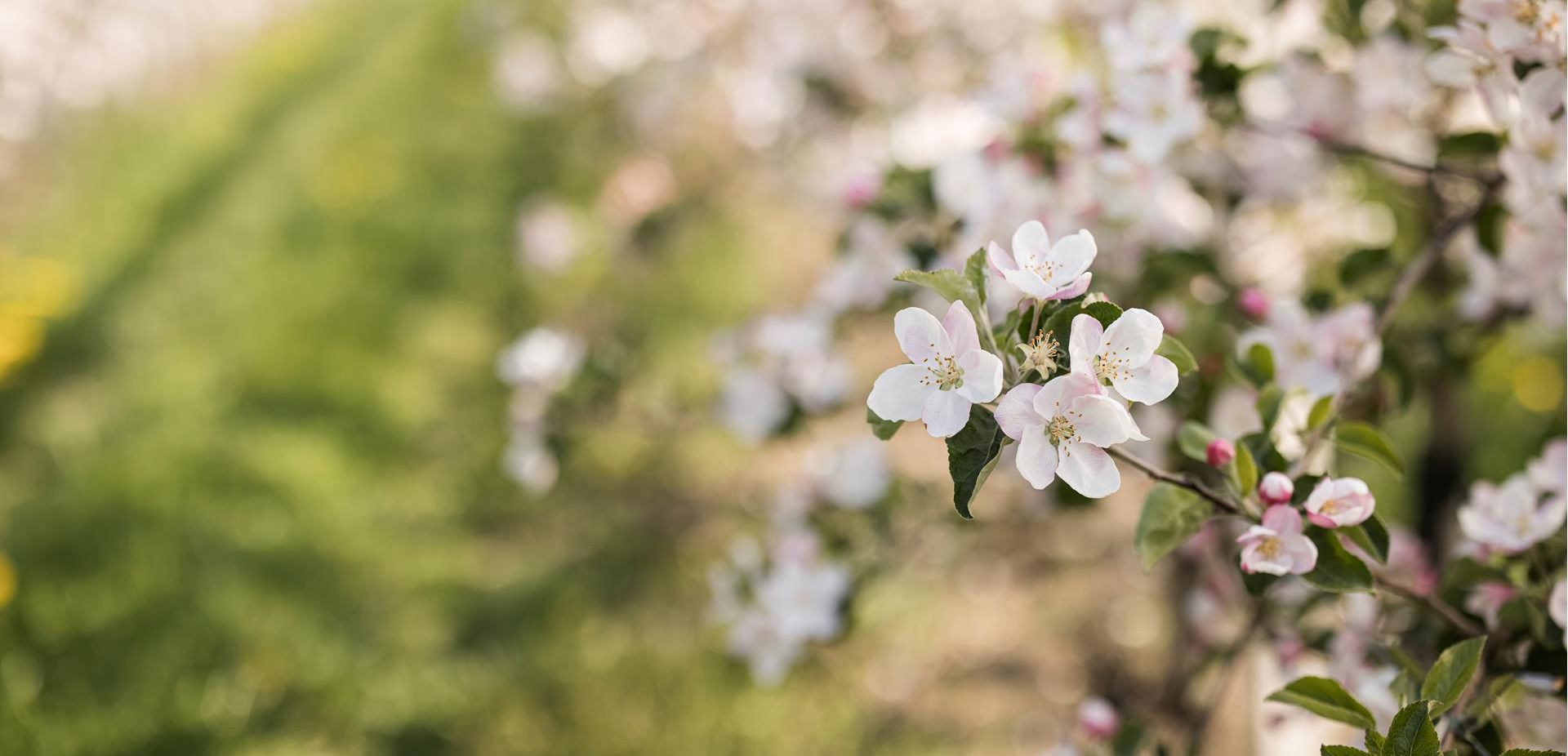
April
Flowering.
From the beginning to full bloom. Countless flowers: hundreds, thousands on each apple tree. Breathtakingly beautiful. The bad news: if they all remain on the tree, an overhang will result. In the event, the apples will ripen poorly and fail to develop the required size and flavour characteristics. This is why we thin the flowers mechanically, with a rotor.
Flowers attract bees. Our own, or the bees of neighbouring beekeepers. In some tramlines, we sow cover crops. Their roots penetrate the soil, they offer natural antagonists a habitat, they blossom for insects. And for our eyes. Breathtakingly beautiful.
In the new apple orchards, it is time to plant the curated saplings in the prepared furrows. Before they have developed deep roots, they support themselves on the wires that we stretched between the pillars. They grow for the next two years and bear only a little fruit. From the third year, they present us with an abundance of our favourite fruit.
Flowers attract bees. Our own, or the bees of neighbouring beekeepers. In some tramlines, we sow cover crops. Their roots penetrate the soil, they offer natural antagonists a habitat, they blossom for insects. And for our eyes. Breathtakingly beautiful.
In the new apple orchards, it is time to plant the curated saplings in the prepared furrows. Before they have developed deep roots, they support themselves on the wires that we stretched between the pillars. They grow for the next two years and bear only a little fruit. From the third year, they present us with an abundance of our favourite fruit.
From the beginning to full bloom. Countless flowers: hundreds, thousands on each apple tree. Breathtakingly beautiful. The bad news: if they all remain on the tree, an overhang will result. In the event, the apples will ripen poorly and fail to develop the required size and flavour characteristics. This is why we thin the flowers mechanically, with a rotor.
Flowers attract bees. Our own, or the bees of neighbouring beekeepers. In some tramlines, we sow cover crops. Their roots penetrate the soil, they offer natural antagonists a habitat, they blossom for insects. And for our eyes. Breathtakingly beautiful.
In the new apple orchards, it is time to plant the curated saplings in the prepared furrows. Before they have developed deep roots, they support themselves on the wires that we stretched between the pillars. They grow for the next two years and bear only a little fruit. From the third year, they present us with an abundance of our favourite fruit.
Flowers attract bees. Our own, or the bees of neighbouring beekeepers. In some tramlines, we sow cover crops. Their roots penetrate the soil, they offer natural antagonists a habitat, they blossom for insects. And for our eyes. Breathtakingly beautiful.
In the new apple orchards, it is time to plant the curated saplings in the prepared furrows. Before they have developed deep roots, they support themselves on the wires that we stretched between the pillars. They grow for the next two years and bear only a little fruit. From the third year, they present us with an abundance of our favourite fruit.
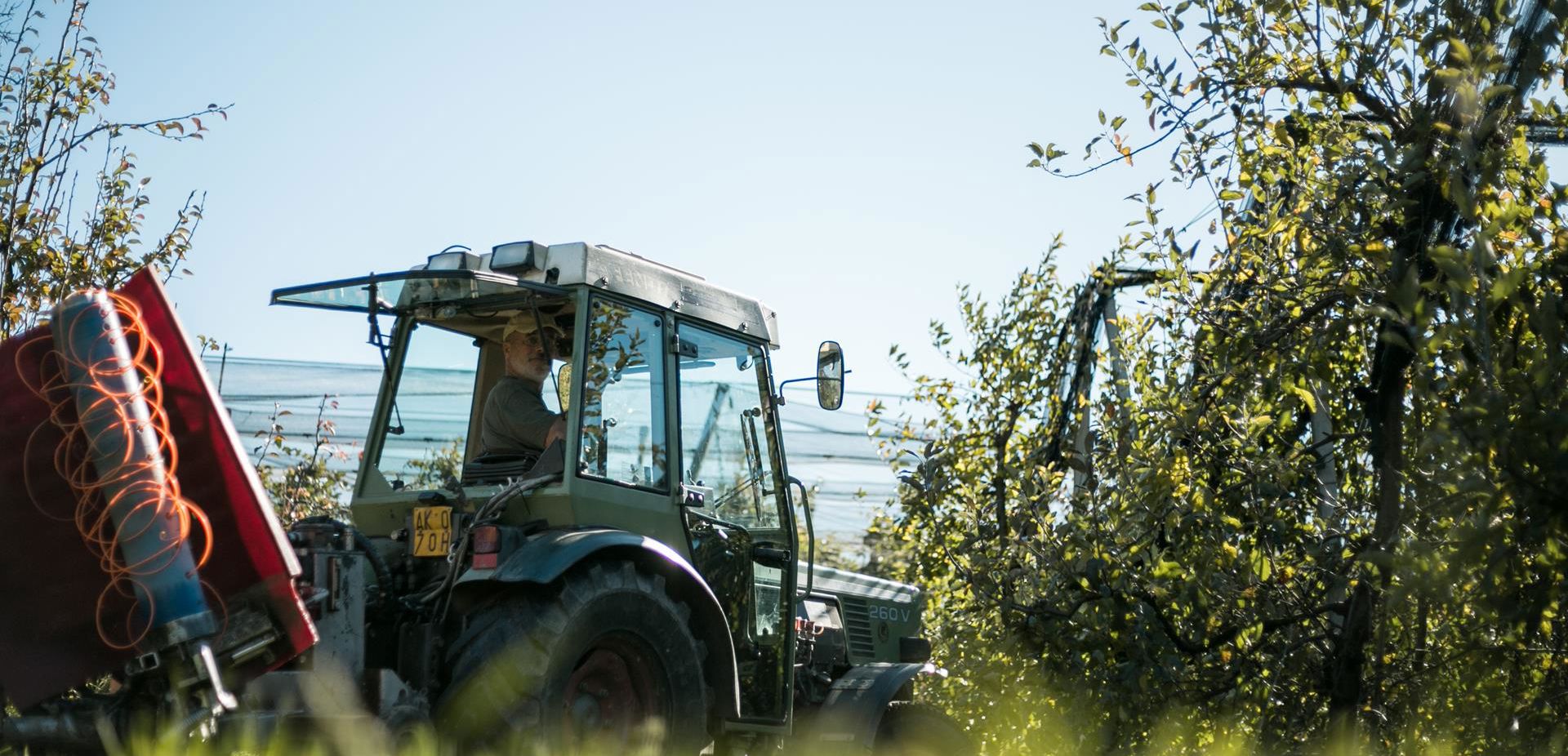
May
Protection.
Without plant protection, aphids, fungi and scab enjoy easy access. This is why we also help to protect our organic orchards. But with alternative means. We organic farmers only use substances that occur in nature and only use nature-identical pesticides. With rigorously agreed limit values that are monitored just as rigorously.
Now is also the best time to till the soil. Crumbling clears the rows, loosens up the soil and enriches it with oxygen. The apple trees receive more nutrients and can absorb water more efficiently, and this in turn benefits fruit growth. We also mulch the apple trees: cover the soil around them with organic material. Alongside grass clippings, tree bark, straw and compost have a beneficial effect. Mulching admits valuable nutrients into the soil and the extra layer protects the soil against drying out. It also suppresses the growth of weeds.
After the late spring frost that usually occurs mid-May, most nights are frost-free. Now the apples are in the cell division phase in which they prepare for their growth spurt.
Now is also the best time to till the soil. Crumbling clears the rows, loosens up the soil and enriches it with oxygen. The apple trees receive more nutrients and can absorb water more efficiently, and this in turn benefits fruit growth. We also mulch the apple trees: cover the soil around them with organic material. Alongside grass clippings, tree bark, straw and compost have a beneficial effect. Mulching admits valuable nutrients into the soil and the extra layer protects the soil against drying out. It also suppresses the growth of weeds.
After the late spring frost that usually occurs mid-May, most nights are frost-free. Now the apples are in the cell division phase in which they prepare for their growth spurt.
Without plant protection, aphids, fungi and scab enjoy easy access. This is why we also help to protect our organic orchards. But with alternative means. We organic farmers only use substances that occur in nature and only use nature-identical pesticides. With rigorously agreed limit values that are monitored just as rigorously.
Now is also the best time to till the soil. Crumbling clears the rows, loosens up the soil and enriches it with oxygen. The apple trees receive more nutrients and can absorb water more efficiently, and this in turn benefits fruit growth. We also mulch the apple trees: cover the soil around them with organic material. Alongside grass clippings, tree bark, straw and compost have a beneficial effect. Mulching admits valuable nutrients into the soil and the extra layer protects the soil against drying out. It also suppresses the growth of weeds.
After the late spring frost that usually occurs mid-May, most nights are frost-free. Now the apples are in the cell division phase in which they prepare for their growth spurt.
Now is also the best time to till the soil. Crumbling clears the rows, loosens up the soil and enriches it with oxygen. The apple trees receive more nutrients and can absorb water more efficiently, and this in turn benefits fruit growth. We also mulch the apple trees: cover the soil around them with organic material. Alongside grass clippings, tree bark, straw and compost have a beneficial effect. Mulching admits valuable nutrients into the soil and the extra layer protects the soil against drying out. It also suppresses the growth of weeds.
After the late spring frost that usually occurs mid-May, most nights are frost-free. Now the apples are in the cell division phase in which they prepare for their growth spurt.
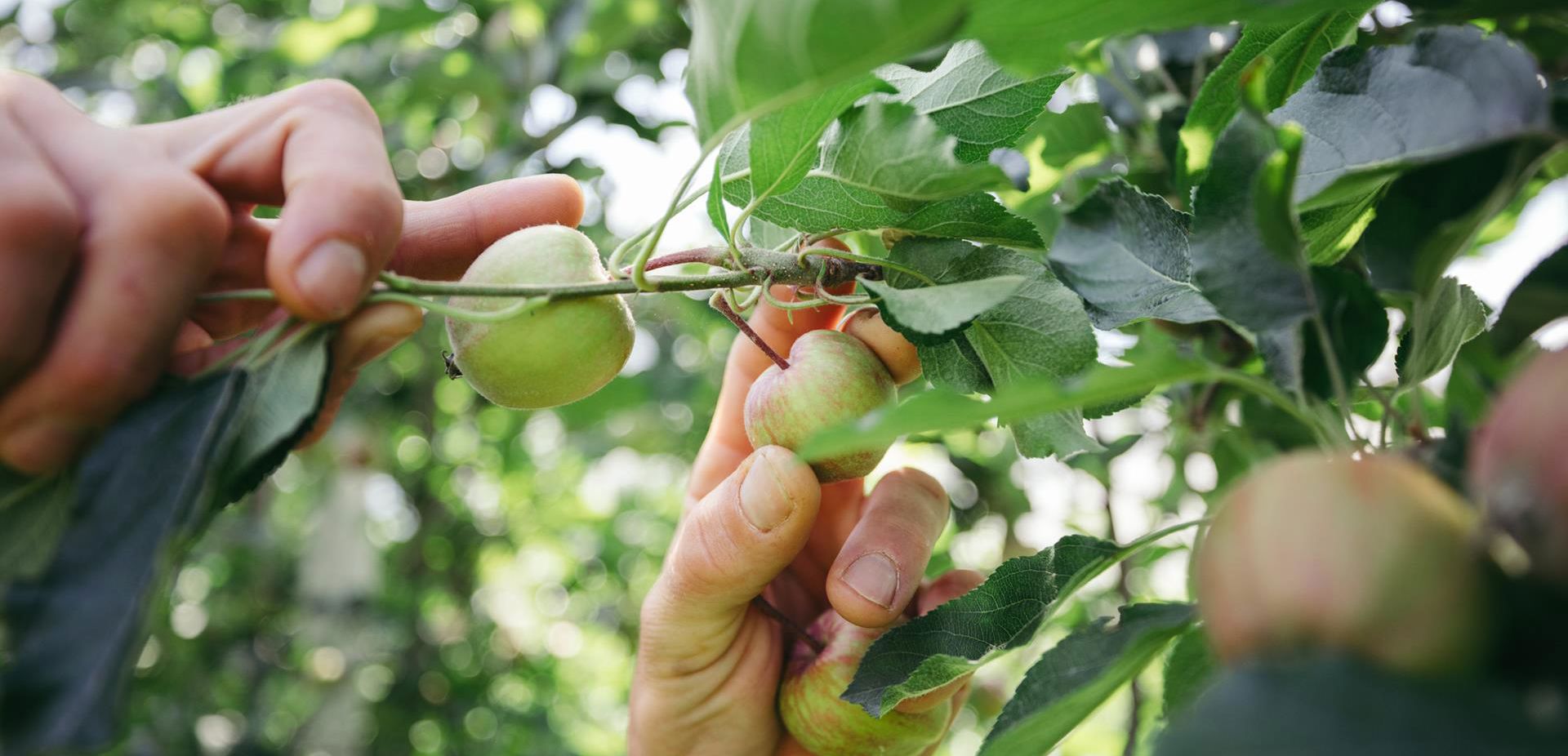
June
Selection.
Thinning out. Thinning out. Thinning out. Although the flowers were thinned out in April, there is still too much fruit on the trees. Small, poorly developed, damaged or surplus fruit is plucked from the branches by hand now. Identified with a trained eye and easily separated by a quick thumb and index finger. They make way for larger, stronger fruit and enable the trees to nourish the remaining fruit with all their power. For ideal growth, optimal colouration and an excellent harvest. They simply fall to the ground. And return to the cycle of nature.
The weather decides when the hail nets are closed. For protection against destructive showers, and against too much sun as well.
The weather decides when the hail nets are closed. For protection against destructive showers, and against too much sun as well.
Thinning out. Thinning out. Thinning out. Although the flowers were thinned out in April, there is still too much fruit on the trees. Small, poorly developed, damaged or surplus fruit is plucked from the branches by hand now. Identified with a trained eye and easily separated by a quick thumb and index finger. They make way for larger, stronger fruit and enable the trees to nourish the remaining fruit with all their power. For ideal growth, optimal colouration and an excellent harvest. They simply fall to the ground. And return to the cycle of nature.
The weather decides when the hail nets are closed. For protection against destructive showers, and against too much sun as well.
The weather decides when the hail nets are closed. For protection against destructive showers, and against too much sun as well.
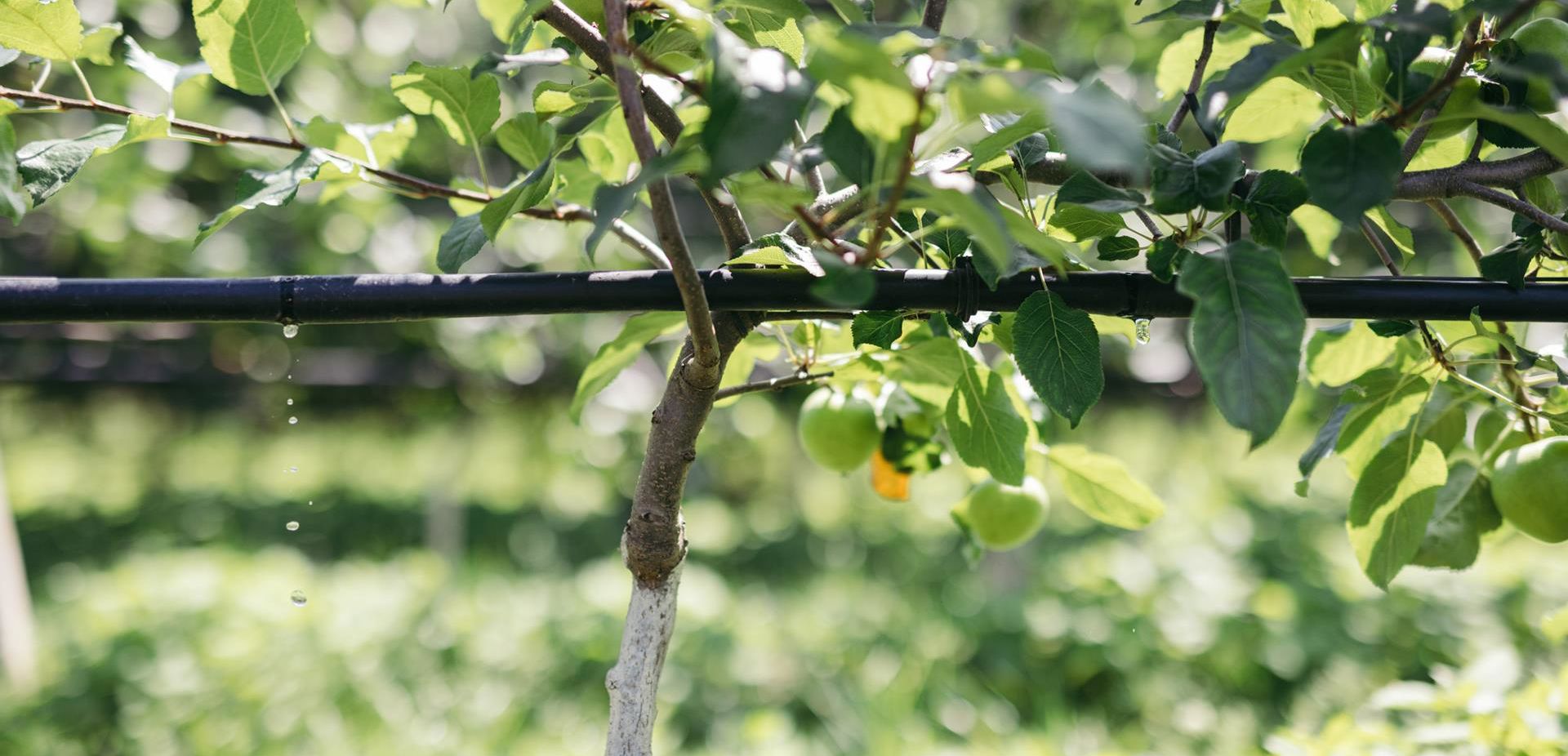
July
Anticipation.
The drip irrigation in our orchards sets to work in the summer heat. It systematically applies water instead of wasting it. We are already thinking about the next step. Planning our harvest. Contacting our harvest workers. From the region and around the world. We have known many of them for years and some of them for decades.
Trust is good, but control is better. During the growing season from April to October, internal inspectors and external auditors can knock on the door to the farm at any time. They take a critical look at our orchard register, our farms, our orchards... and also at the accommodations for our harvest workers. That’s good!
Trust is good, but control is better. During the growing season from April to October, internal inspectors and external auditors can knock on the door to the farm at any time. They take a critical look at our orchard register, our farms, our orchards... and also at the accommodations for our harvest workers. That’s good!
The drip irrigation in our orchards sets to work in the summer heat. It systematically applies water instead of wasting it. We are already thinking about the next step. Planning our harvest. Contacting our harvest workers. From the region and around the world. We have known many of them for years and some of them for decades.
Trust is good, but control is better. During the growing season from April to October, internal inspectors and external auditors can knock on the door to the farm at any time. They take a critical look at our orchard register, our farms, our orchards... and also at the accommodations for our harvest workers. That’s good!
Trust is good, but control is better. During the growing season from April to October, internal inspectors and external auditors can knock on the door to the farm at any time. They take a critical look at our orchard register, our farms, our orchards... and also at the accommodations for our harvest workers. That’s good!
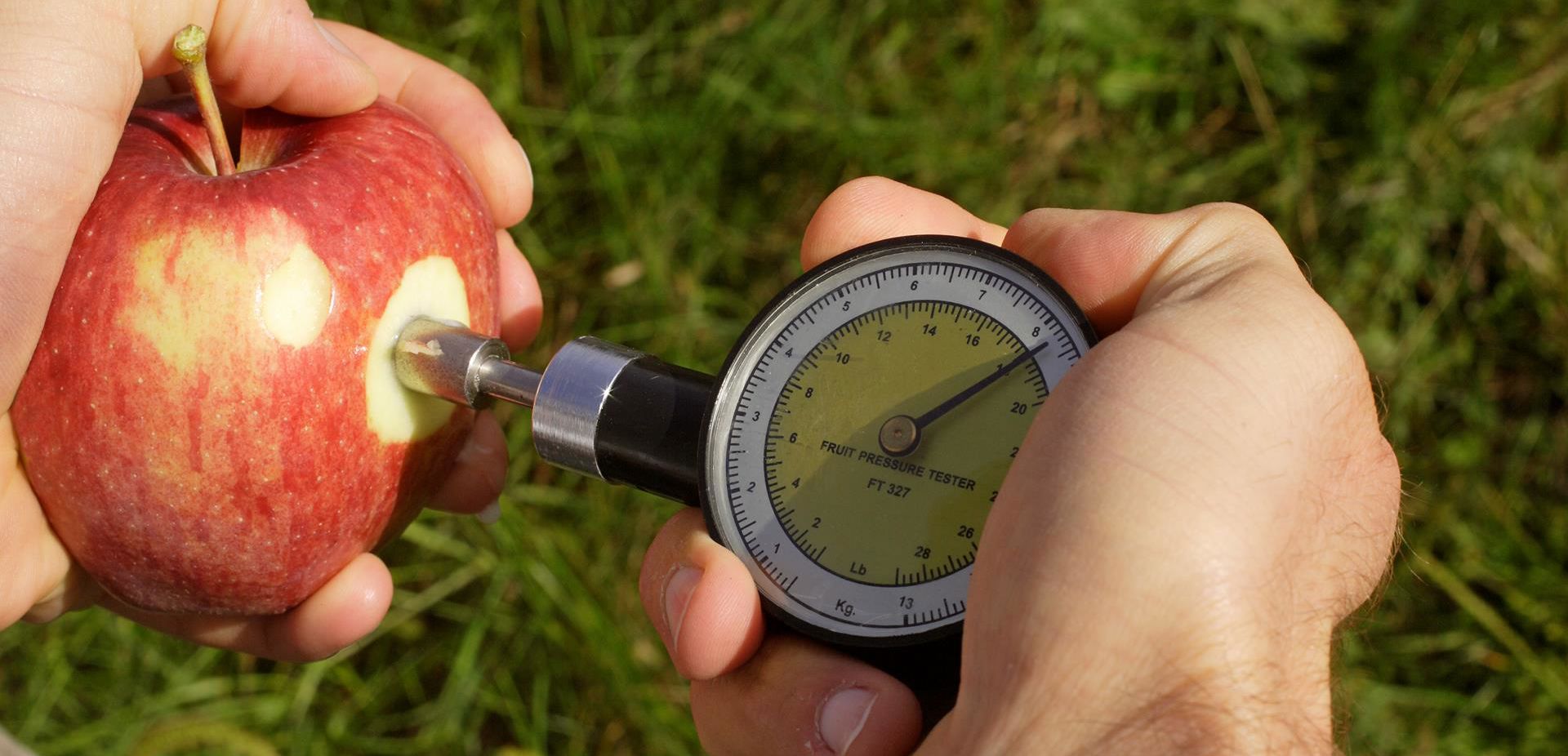
August
Ripeness.
The right time for harvesting is crucial. At that time, flavour development, shelf life and storage compatibility are ideal. The altitude, weather and solar irradiation all influence ripeness, and therefore between two and five picking rounds per variety are necessary. Random samples with tests for starch degradation, among others, help to determine the degree of ripeness. They reveal the harvesting schedule to us and define the harvest window. And also provide the information to our fellow farmers.
And our own random samples are what distinguish our apples as 100% “organic” – taken with greater frequency on the boundaries to orchards with integrated apple cultivation. Free from prohibited pesticides, pure nature.
And then it’s harvest time! The first early varieties are ripe for the picking. Empty apple crates are filled: a solid 300 kilogrammes of pleasure. The perfect size and beautifully ripe. Apple by apple, hand by hand. Some of the apples need a bit more time. We’ll return later.
And our own random samples are what distinguish our apples as 100% “organic” – taken with greater frequency on the boundaries to orchards with integrated apple cultivation. Free from prohibited pesticides, pure nature.
And then it’s harvest time! The first early varieties are ripe for the picking. Empty apple crates are filled: a solid 300 kilogrammes of pleasure. The perfect size and beautifully ripe. Apple by apple, hand by hand. Some of the apples need a bit more time. We’ll return later.
The right time for harvesting is crucial. At that time, flavour development, shelf life and storage compatibility are ideal. The altitude, weather and solar irradiation all influence ripeness, and therefore between two and five picking rounds per variety are necessary. Random samples with tests for starch degradation, among others, help to determine the degree of ripeness. They reveal the harvesting schedule to us and define the harvest window. And also provide the information to our fellow farmers.
And our own random samples are what distinguish our apples as 100% “organic” – taken with greater frequency on the boundaries to orchards with integrated apple cultivation. Free from prohibited pesticides, pure nature.
And then it’s harvest time! The first early varieties are ripe for the picking. Empty apple crates are filled: a solid 300 kilogrammes of pleasure. The perfect size and beautifully ripe. Apple by apple, hand by hand. Some of the apples need a bit more time. We’ll return later.
And our own random samples are what distinguish our apples as 100% “organic” – taken with greater frequency on the boundaries to orchards with integrated apple cultivation. Free from prohibited pesticides, pure nature.
And then it’s harvest time! The first early varieties are ripe for the picking. Empty apple crates are filled: a solid 300 kilogrammes of pleasure. The perfect size and beautifully ripe. Apple by apple, hand by hand. Some of the apples need a bit more time. We’ll return later.
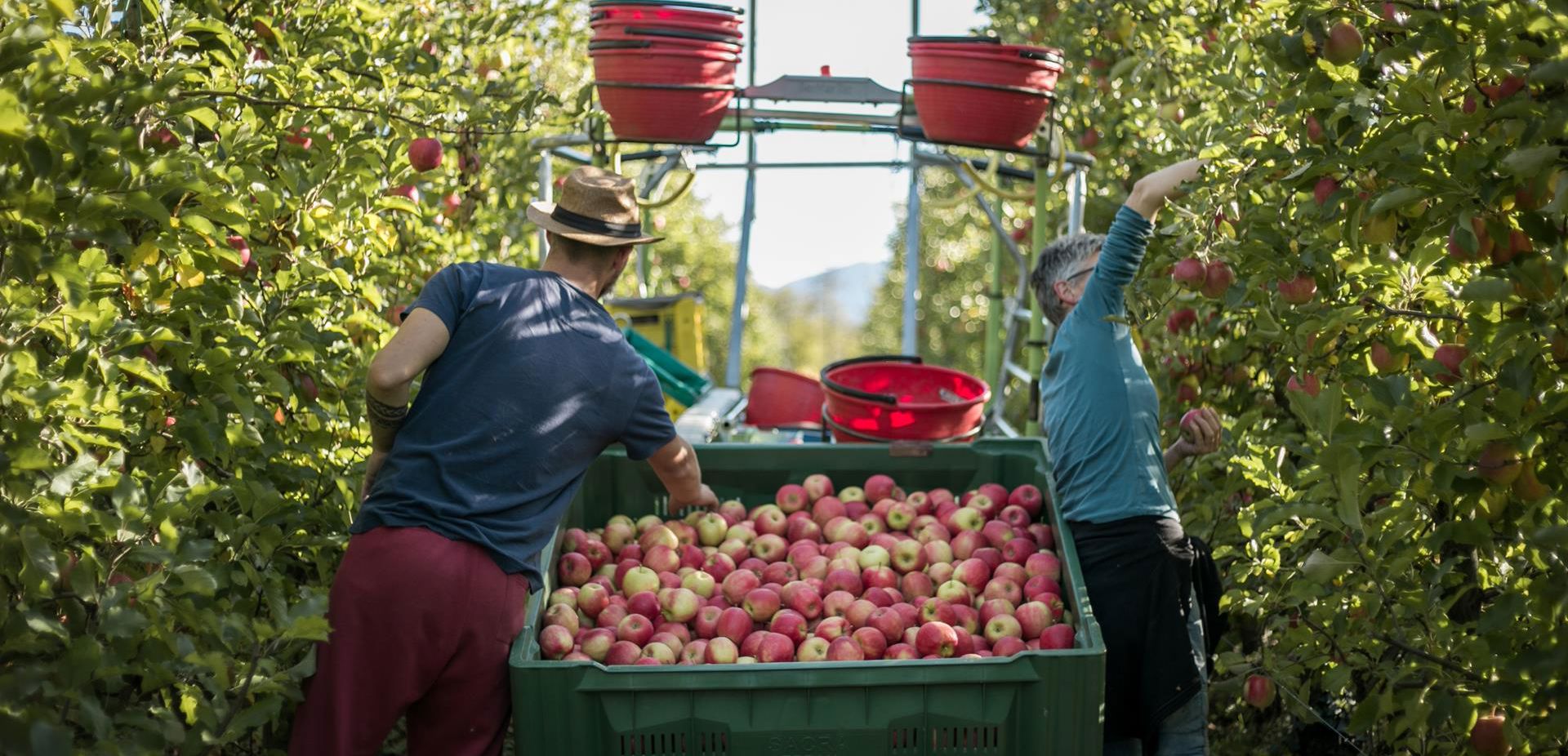
September
Fruit.
Many of our apple varieties were harvested some time ago, while others are now on their third or fourth picking round. And some don’t take centre stage until September. Orchard by orchard, tree by tree and apple by apple – this is how we gather the fruits of our work year.
Crate by crate, they are transported to the cooperative, where they are stored. The season also starts for the sorting line. A productive year gets the green light. It selects the apples according to size, weight and quality. In the process, they are cleaned, measured, weighed and scanned. And sorted, of course. In the packing room, each apple is carefully inspected again before it lands in the packaging with its colleagues. Apple by apple, crate by crate. Grouped onto pallets and loaded into refrigerator lorries. Fresh fruit section, here we come!
Crate by crate, they are transported to the cooperative, where they are stored. The season also starts for the sorting line. A productive year gets the green light. It selects the apples according to size, weight and quality. In the process, they are cleaned, measured, weighed and scanned. And sorted, of course. In the packing room, each apple is carefully inspected again before it lands in the packaging with its colleagues. Apple by apple, crate by crate. Grouped onto pallets and loaded into refrigerator lorries. Fresh fruit section, here we come!
Many of our apple varieties were harvested some time ago, while others are now on their third or fourth picking round. And some don’t take centre stage until September. Orchard by orchard, tree by tree and apple by apple – this is how we gather the fruits of our work year.
Crate by crate, they are transported to the cooperative, where they are stored. The season also starts for the sorting line. A productive year gets the green light. It selects the apples according to size, weight and quality. In the process, they are cleaned, measured, weighed and scanned. And sorted, of course. In the packing room, each apple is carefully inspected again before it lands in the packaging with its colleagues. Apple by apple, crate by crate. Grouped onto pallets and loaded into refrigerator lorries. Fresh fruit section, here we come!
Crate by crate, they are transported to the cooperative, where they are stored. The season also starts for the sorting line. A productive year gets the green light. It selects the apples according to size, weight and quality. In the process, they are cleaned, measured, weighed and scanned. And sorted, of course. In the packing room, each apple is carefully inspected again before it lands in the packaging with its colleagues. Apple by apple, crate by crate. Grouped onto pallets and loaded into refrigerator lorries. Fresh fruit section, here we come!
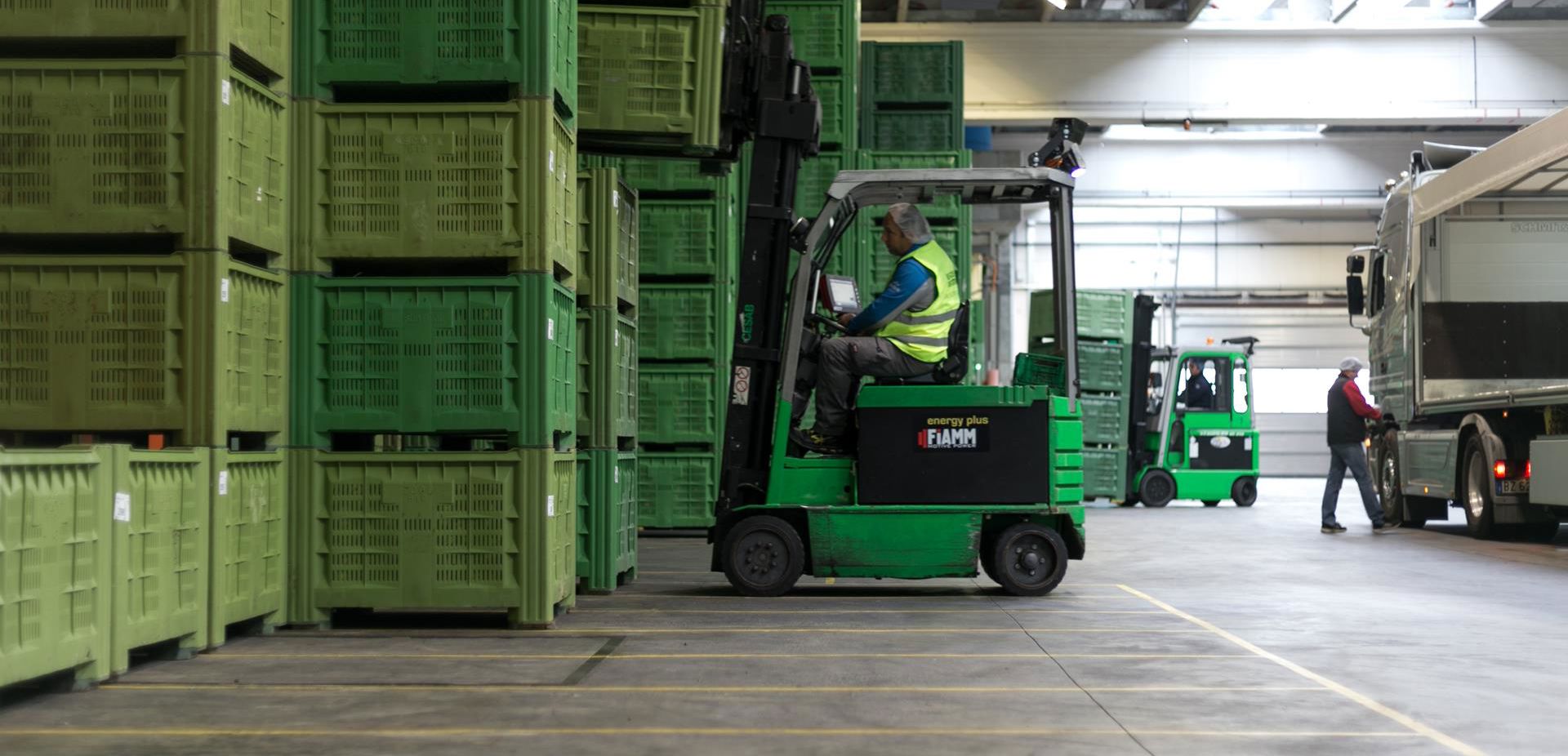
October
Late varieties.
At this time, we harvest our late varieties. Crate by crate, they join their colleagues in the cooperative, where they are sorted, packaged and loaded. We store the apples that are not immediately sold in locked refrigeration cells until we find their sales opportunities. A special oxygen-nitrogen mixture puts them to sleep: they breathe more slowly and their ripening process decelerates. They remain fresh and crispy; even for months at a time.
And thanks to our wide range of varieties, their excellent storage compatibility and long shelf life, we are diverse enough to perfectly cover an entire year.
And thanks to our wide range of varieties, their excellent storage compatibility and long shelf life, we are diverse enough to perfectly cover an entire year.
At this time, we harvest our late varieties. Crate by crate, they join their colleagues in the cooperative, where they are sorted, packaged and loaded. We store the apples that are not immediately sold in locked refrigeration cells until we find their sales opportunities. A special oxygen-nitrogen mixture puts them to sleep: they breathe more slowly and their ripening process decelerates. They remain fresh and crispy; even for months at a time.
And thanks to our wide range of varieties, their excellent storage compatibility and long shelf life, we are diverse enough to perfectly cover an entire year.
And thanks to our wide range of varieties, their excellent storage compatibility and long shelf life, we are diverse enough to perfectly cover an entire year.
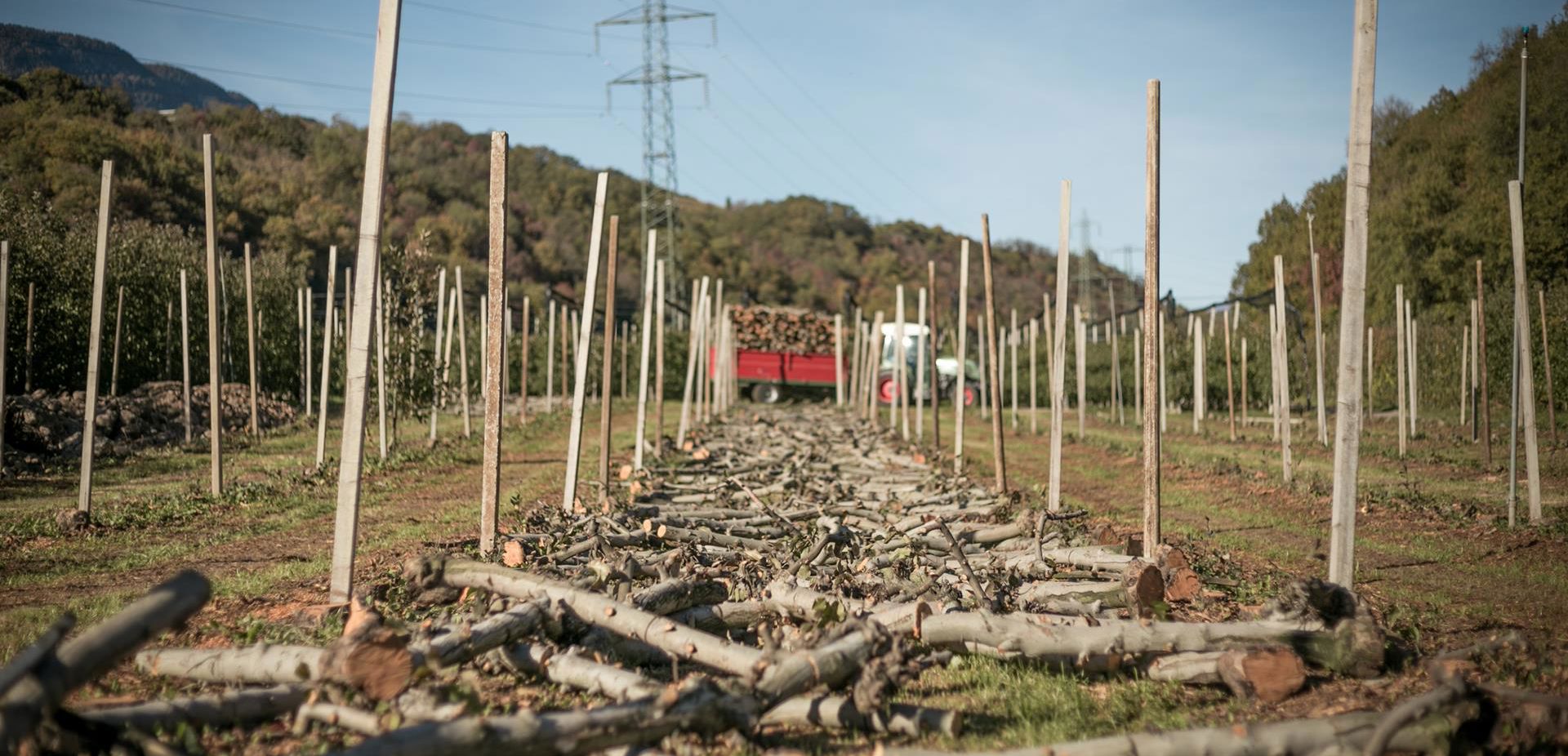
November
Last but not least.
The last apples of a long harvest season are separated from their trees. At the same time, this is the month in which we organic farmers begin to think about next year. Which trees are still good, which ones should we replace? The variety of apple and age of the tree are the key criteria for this decision. A decision about making room for new growth. The excavator does not remove the roots and stump until the pruning shears have lopped off the branches and the chainsaw has cut down the trunk.
We dry the branches, trunks and stumps, and then use them as fuel for our fireplaces. We look forward to the cosy warmth of the parlour when we return home after work on a raw November day. For example, when we make our machines fit to survive the winter by cleaning, lubricating – or, if necessary – repairing them.
We dry the branches, trunks and stumps, and then use them as fuel for our fireplaces. We look forward to the cosy warmth of the parlour when we return home after work on a raw November day. For example, when we make our machines fit to survive the winter by cleaning, lubricating – or, if necessary – repairing them.
The last apples of a long harvest season are separated from their trees. At the same time, this is the month in which we organic farmers begin to think about next year. Which trees are still good, which ones should we replace? The variety of apple and age of the tree are the key criteria for this decision. A decision about making room for new growth. The excavator does not remove the roots and stump until the pruning shears have lopped off the branches and the chainsaw has cut down the trunk.
We dry the branches, trunks and stumps, and then use them as fuel for our fireplaces. We look forward to the cosy warmth of the parlour when we return home after work on a raw November day. For example, when we make our machines fit to survive the winter by cleaning, lubricating – or, if necessary – repairing them.
We dry the branches, trunks and stumps, and then use them as fuel for our fireplaces. We look forward to the cosy warmth of the parlour when we return home after work on a raw November day. For example, when we make our machines fit to survive the winter by cleaning, lubricating – or, if necessary – repairing them.
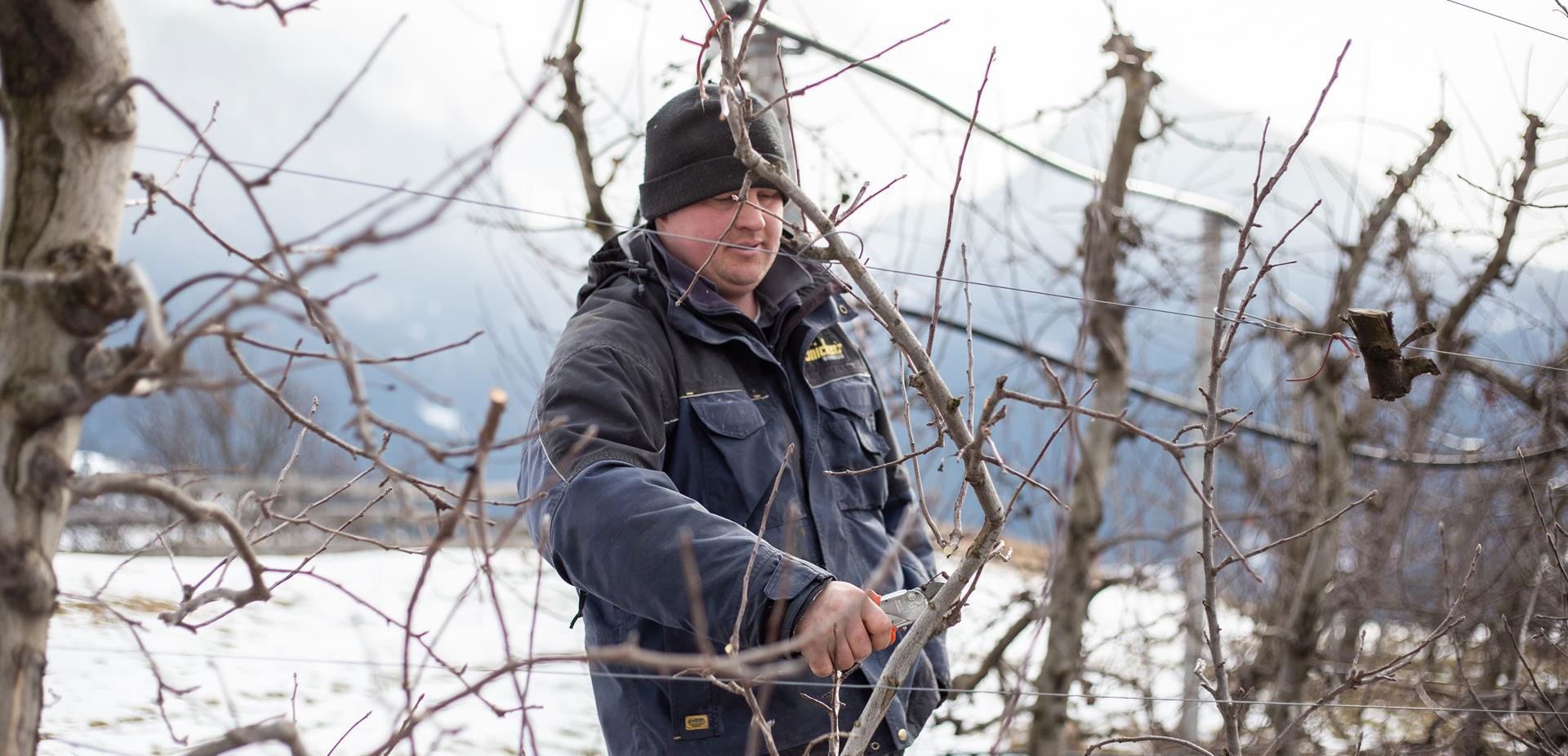
December
Hibernation.
Nature goes into hibernation – and we do the same. We use the quiet time for retrospection and look ahead to the future as well. New machines? New pruning techniques? Innovations in organic farming?
Some of us are even back in the apple orchards, pruning. This helps the plants through their dormancy period and ensures that they can grow properly in the new year. Here’s to a prosperous new year!
Some of us are even back in the apple orchards, pruning. This helps the plants through their dormancy period and ensures that they can grow properly in the new year. Here’s to a prosperous new year!
Nature goes into hibernation – and we do the same. We use the quiet time for retrospection and look ahead to the future as well. New machines? New pruning techniques? Innovations in organic farming?
Some of us are even back in the apple orchards, pruning. This helps the plants through their dormancy period and ensures that they can grow properly in the new year. Here’s to a prosperous new year!
Some of us are even back in the apple orchards, pruning. This helps the plants through their dormancy period and ensures that they can grow properly in the new year. Here’s to a prosperous new year!
January
February
March
April
May
June
July
August
September
October
November
December
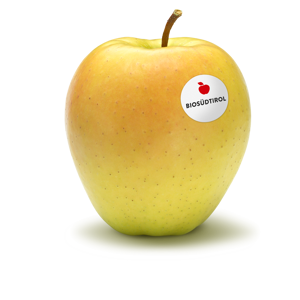
 Golden DeliciousGolden Delicious is particularly known for its versatility in the kitchen and its long shelf life. Kissed by the sun, some of these apples develop a characteristic red cheek.read more
Golden DeliciousGolden Delicious is particularly known for its versatility in the kitchen and its long shelf life. Kissed by the sun, some of these apples develop a characteristic red cheek.read more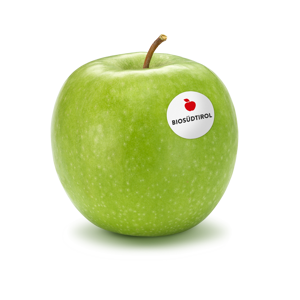
 Granny SmithThe green classic, Granny Smith, is characterized by its refreshingly acidic taste, which sets it apart from other apple varieties. Its tart flavor and crunchy texture make it a versatile and storable fruit.read more
Granny SmithThe green classic, Granny Smith, is characterized by its refreshingly acidic taste, which sets it apart from other apple varieties. Its tart flavor and crunchy texture make it a versatile and storable fruit.read more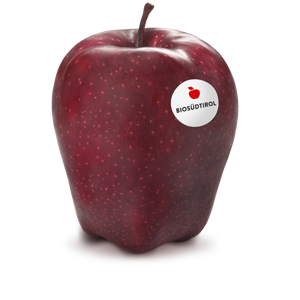
 Red DeliciousBoth its elongated shape with five bumps and its striking dark red color make Red Delicious a real eye-catcher. Its crisp texture and versatility in the kitchen contribute to its enduring popularity.read more
Red DeliciousBoth its elongated shape with five bumps and its striking dark red color make Red Delicious a real eye-catcher. Its crisp texture and versatility in the kitchen contribute to its enduring popularity.read more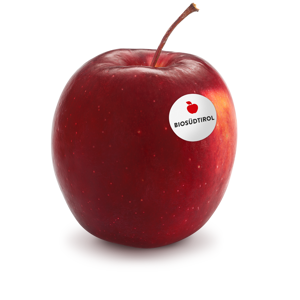
 Story® InoredStory® Inored is crisp and juicy, convincing with its intense sweetness and excellent storability. It thrives in South Tyrol’s mild climate, where it develops its intense red color best.read more
Story® InoredStory® Inored is crisp and juicy, convincing with its intense sweetness and excellent storability. It thrives in South Tyrol’s mild climate, where it develops its intense red color best.read more
Apple varieties:


Golden Delicious
Golden Delicious is particularly known for its versatility in the kitchen and its long shelf life. Kissed by the sun, some of these apples develop a characteristic red cheek.
read more

Granny Smith
The green classic, Granny Smith, is characterized by its refreshingly acidic taste, which sets it apart from other apple varieties. Its tart flavor and crunchy texture make it a versatile and storable fruit.
read more

Red Delicious
Both its elongated shape with five bumps and its striking dark red color make Red Delicious a real eye-catcher. Its crisp texture and versatility in the kitchen contribute to its enduring popularity.
read more

Story® Inored
Story® Inored is crisp and juicy, convincing with its intense sweetness and excellent storability. It thrives in South Tyrol’s mild climate, where it develops its intense red color best.
read more
12 months.
Spring, summer, autumn and winter.
And what happens in our apple orchards in the course of a year? Find out in our brief panorama of twelve lively months.
Find out moreSouth Tyrol.
The home of our organic apples.
300 days of sunshine every year. A mild climate. Clear water. Pure air. Nutrient-rich soil. Apples feel more at home in South Tyrol than anywhere else in Europe.
Find out more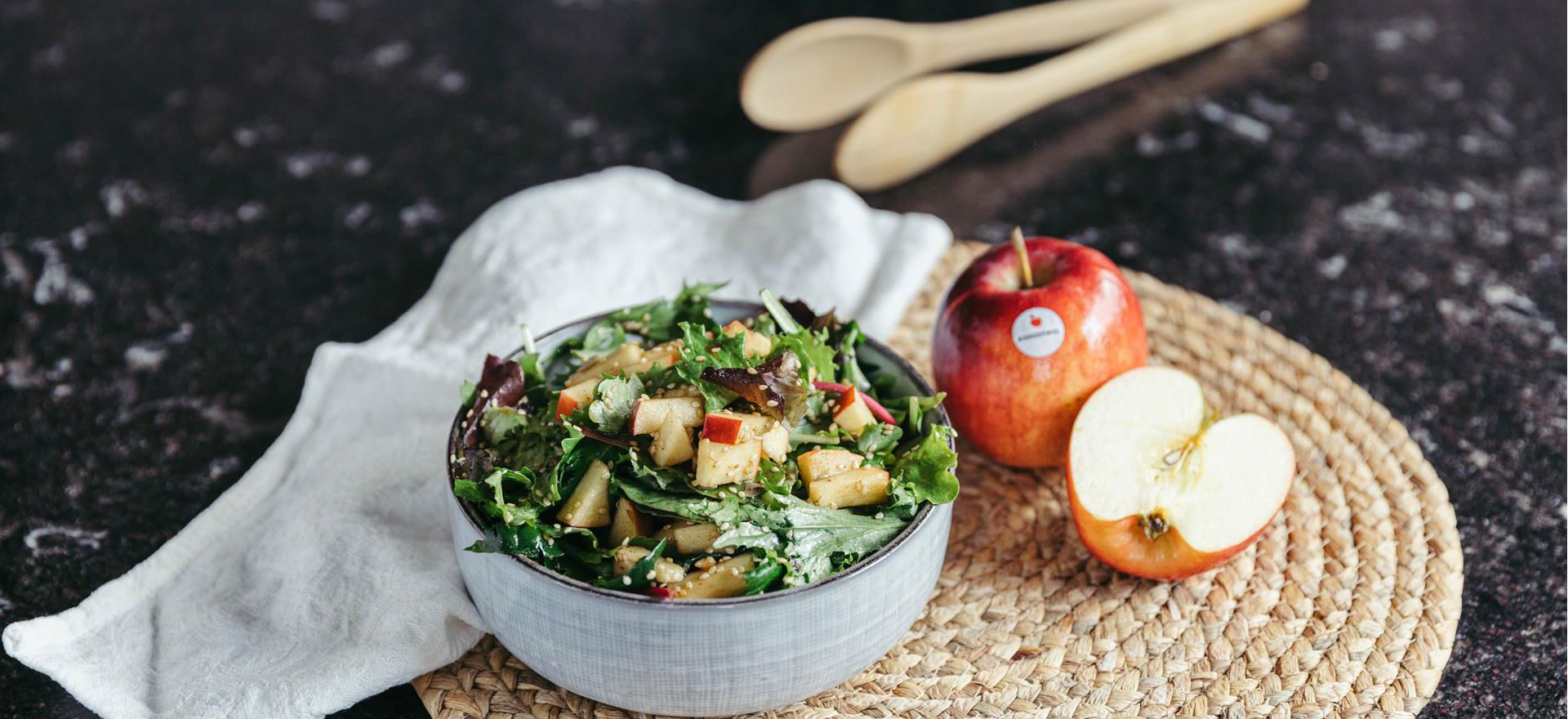 Starter - 15 minutes - EasyOrganic farmer Sissy suggests: apple salad.Recipe
Starter - 15 minutes - EasyOrganic farmer Sissy suggests: apple salad.Recipe![-bp-489659-c-benjamin-pfitscher[2]](/media/713d8f44-def7-4fbc-8322-550d03c09ed1/20250303120707/1920_x_880/-bp-489659-c-benjamin-pfitscher[2].jpg) Dessert - 20 minutes - MediumOrganic farmer Sissy suggests: Apple Roses with Puff PastryRecipe
Dessert - 20 minutes - MediumOrganic farmer Sissy suggests: Apple Roses with Puff PastryRecipe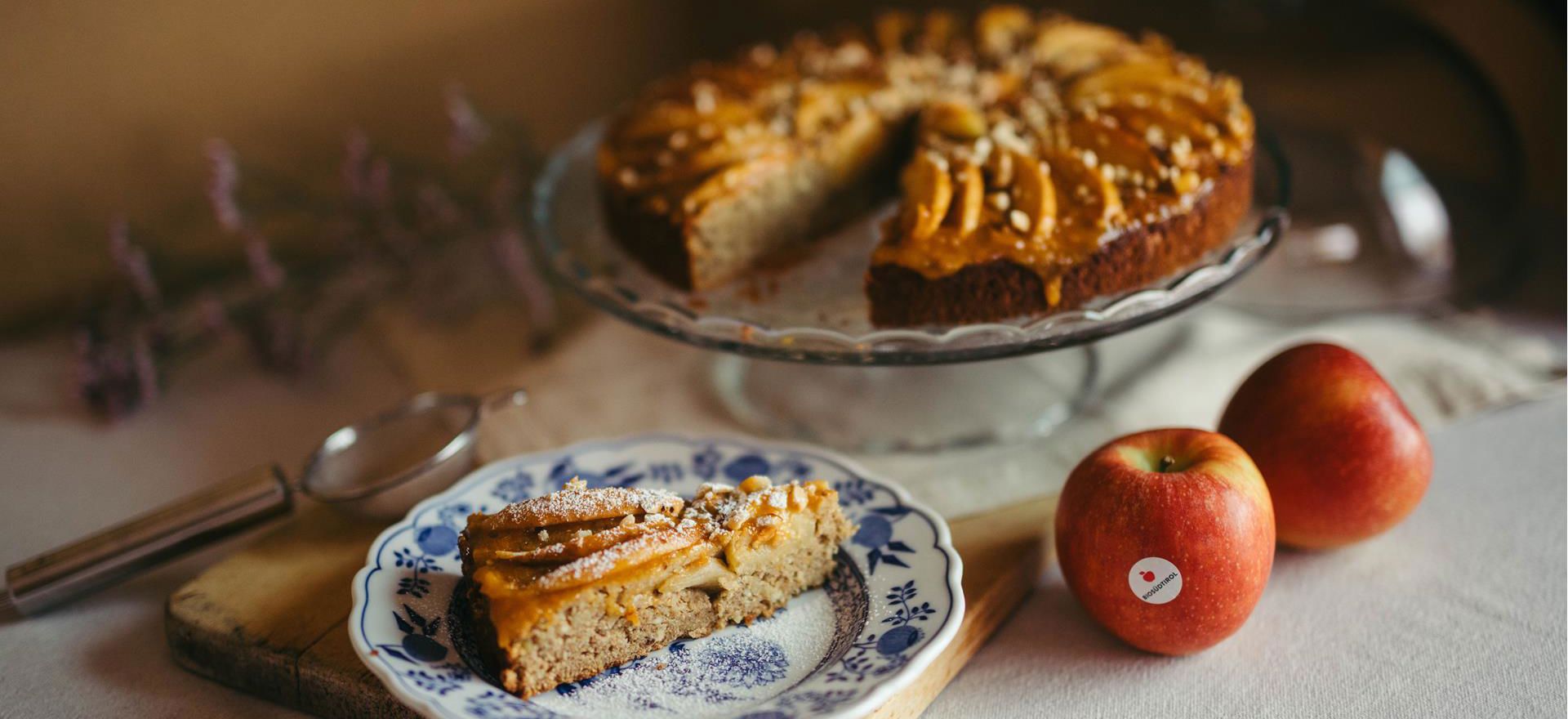 Dessert - about 20 min, plus 40 min baking time - MediumOrganic farmer Sissy serves: Apple Cake.Recipe
Dessert - about 20 min, plus 40 min baking time - MediumOrganic farmer Sissy serves: Apple Cake.Recipe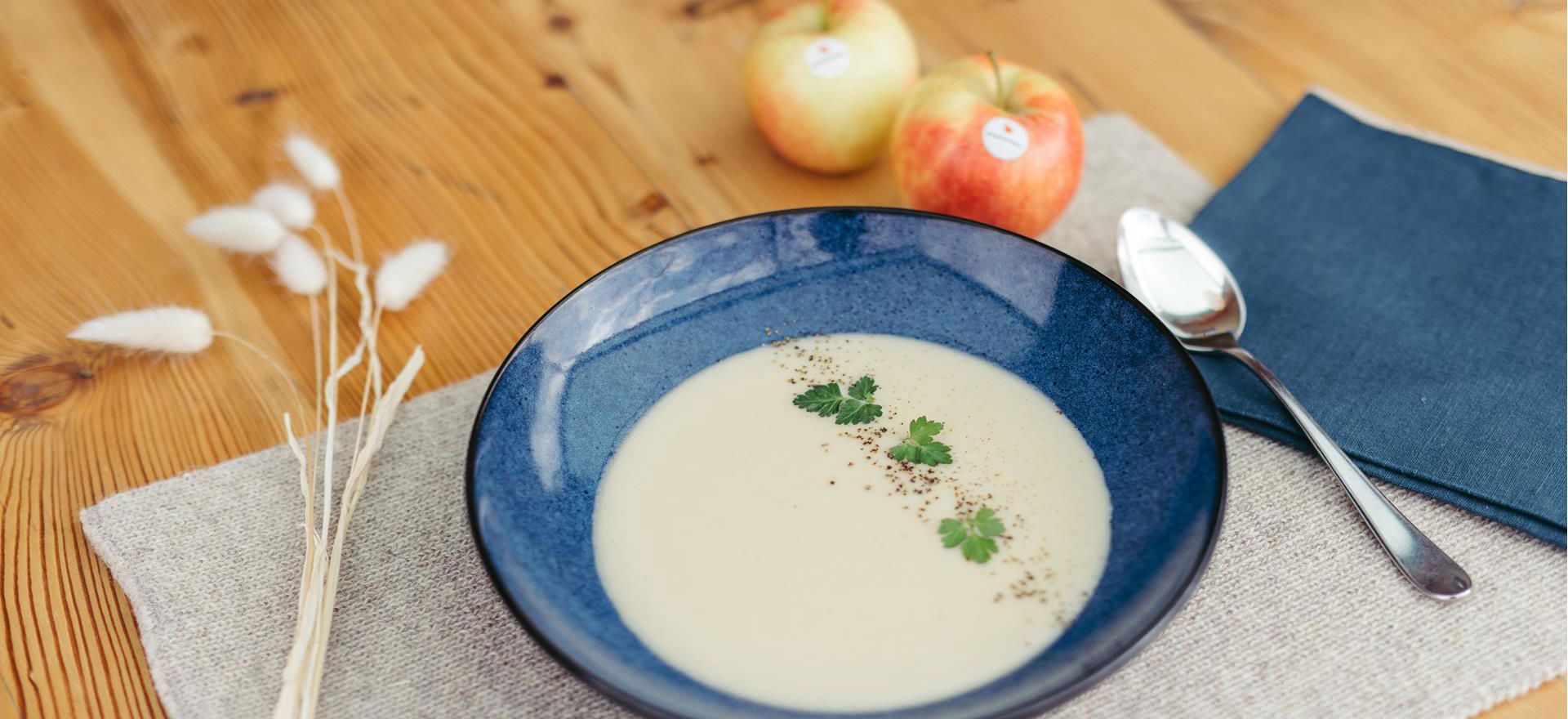 Starter - 20 minutes - MediumBio-Bäuerin Sissy serviert: Apfel-Sellerie Suppe.Recipe
Starter - 20 minutes - MediumBio-Bäuerin Sissy serviert: Apfel-Sellerie Suppe.Recipe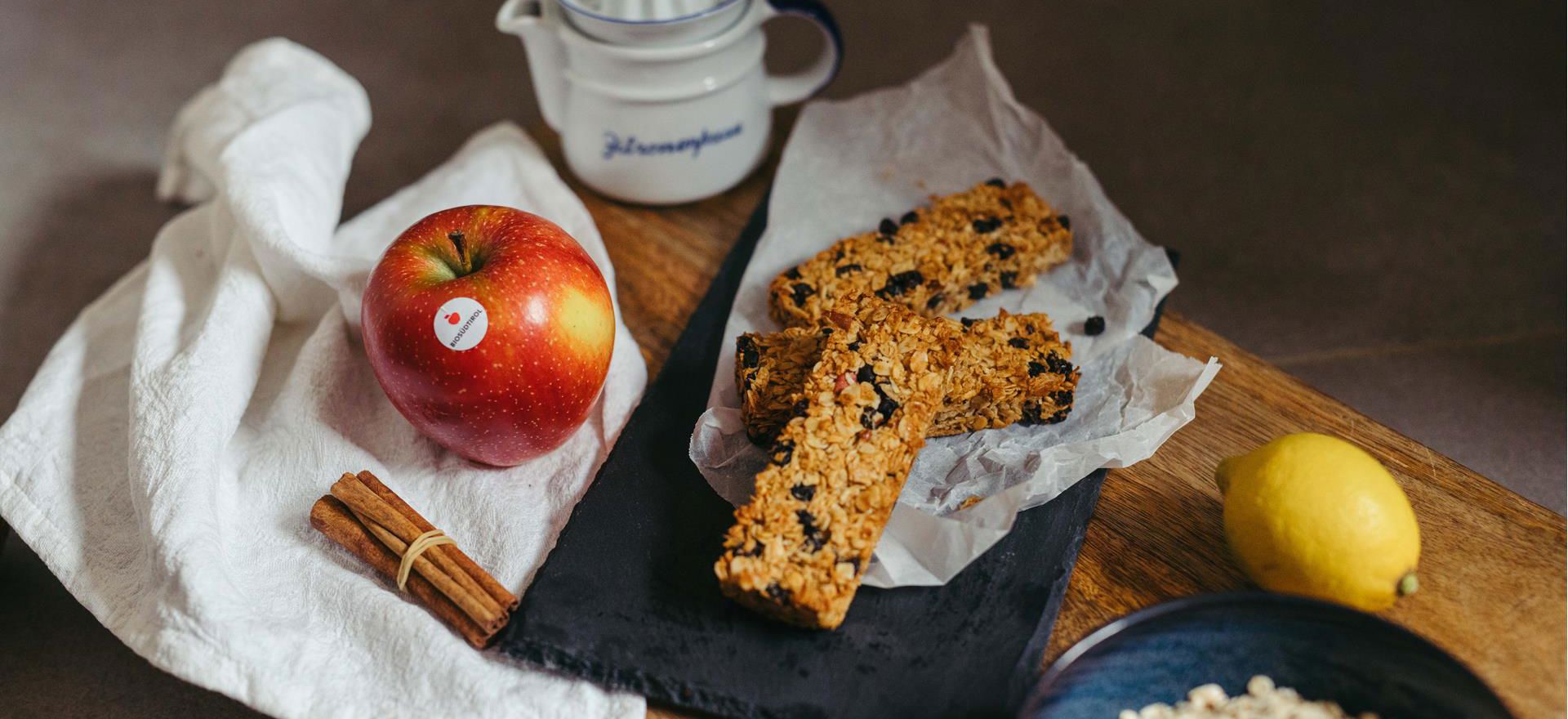 Dessert - about 10 min, plus baking time approximately 25-30 min - MediumOrganic Farmer Sissy presents: Muesli bars.Recipe
Dessert - about 10 min, plus baking time approximately 25-30 min - MediumOrganic Farmer Sissy presents: Muesli bars.Recipe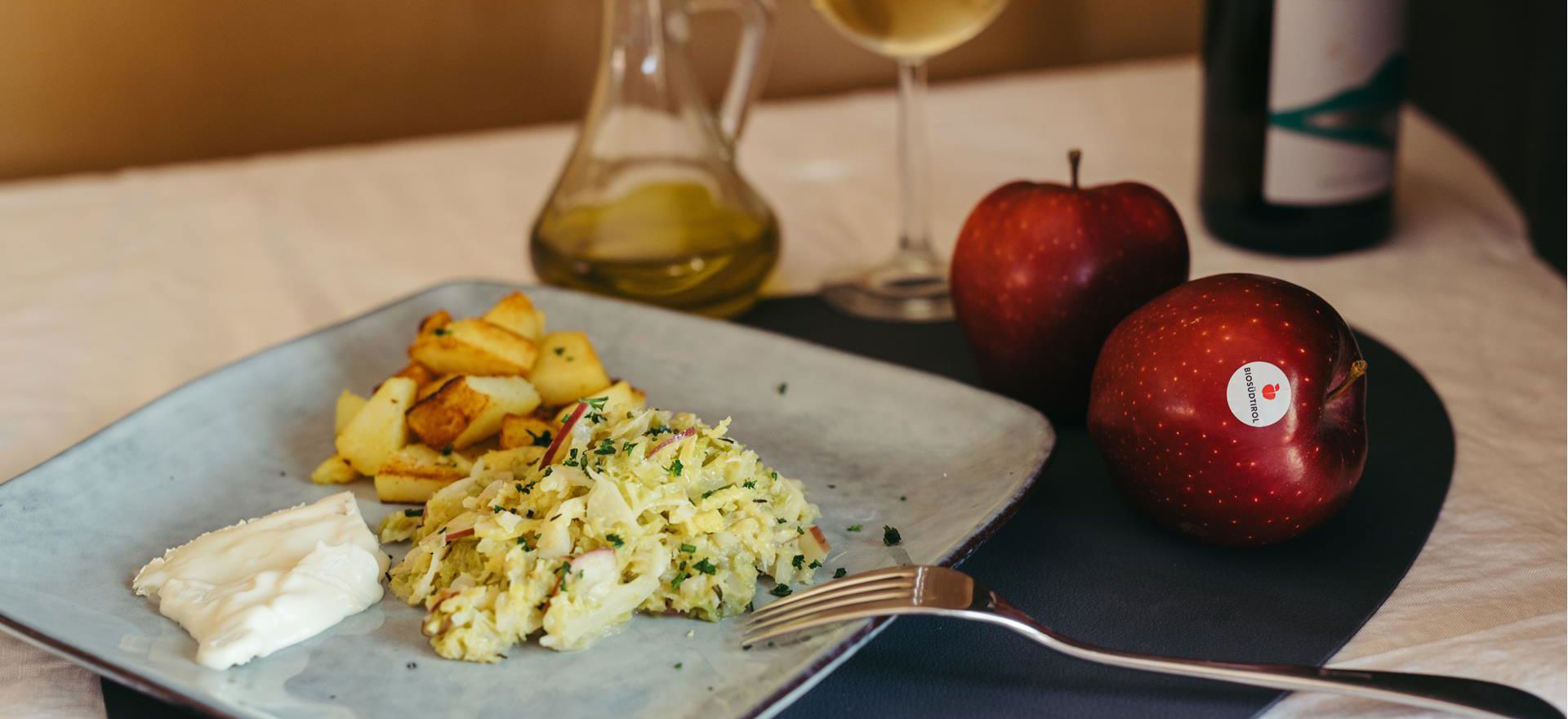 Starter - 25 min - DifficultOrganic farmer Sissy serves: Savoy cabbage with apple.Recipe
Starter - 25 min - DifficultOrganic farmer Sissy serves: Savoy cabbage with apple.Recipe
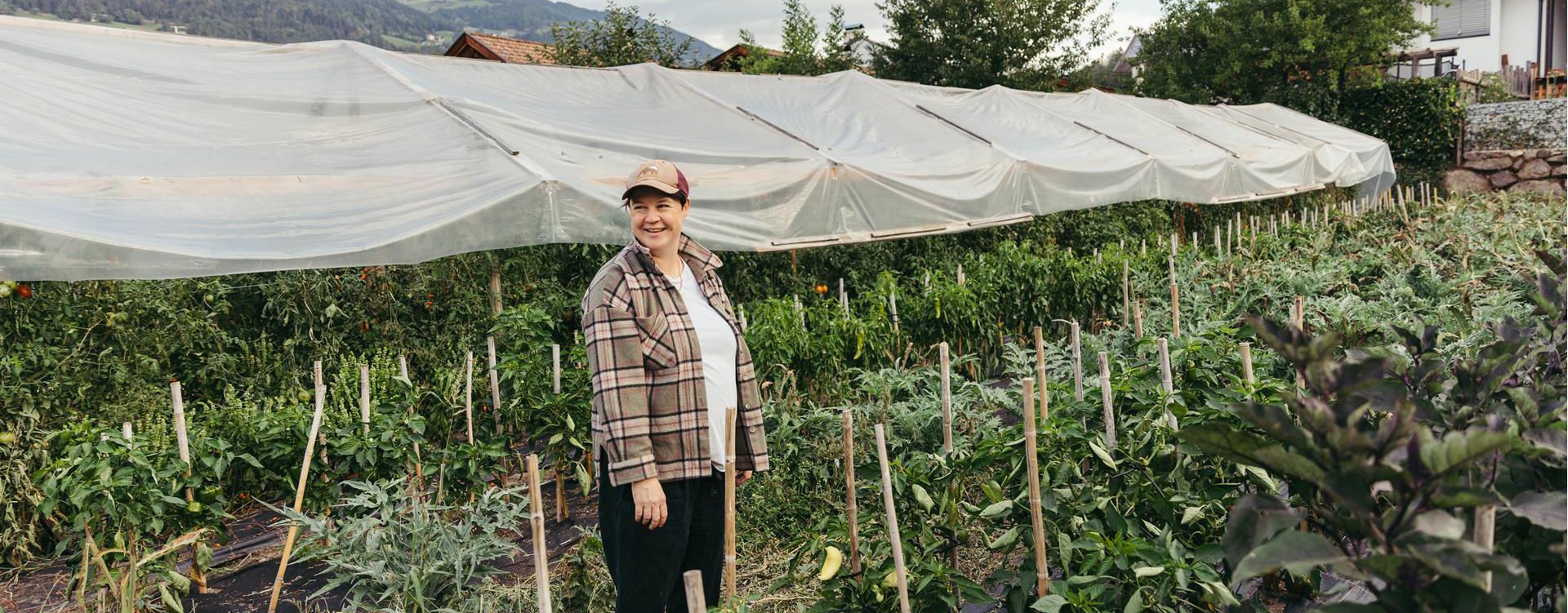
The Diverse One.
Verena Noflatscher
It doesn’t bother Verena that she is “different”. To her, it’s the right way. It’s the way that feels right.
read more
Michaela Mayr.
They applied their “healthy living” philosophy to apple cultivation on their farm, and quickly arrived at an answer: “organic”. They looked each other in the eyes and said that some day, they surely would.
read more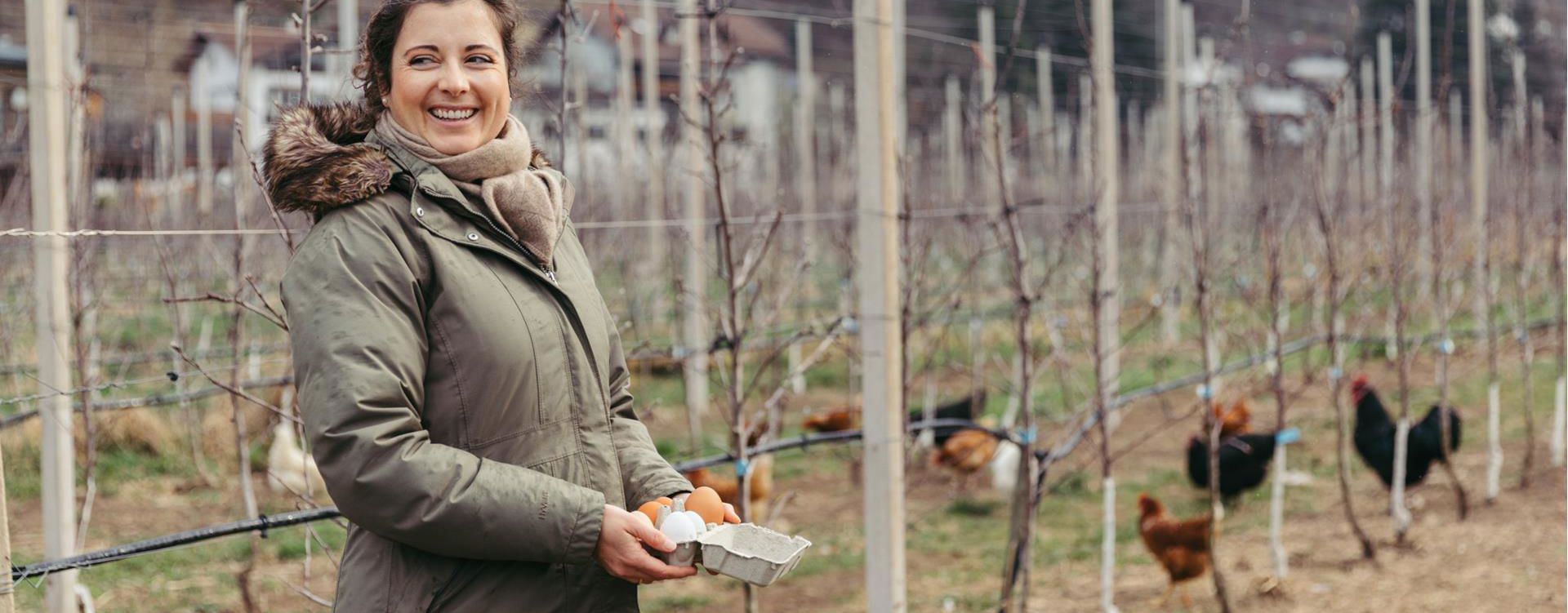
The Versatile One.
Sissy Pfeifer.
At a raised bed and in her kitchen, she is entirely in her element. With a blue apron and the creative ideas that she puts into her healthy recipes.
read more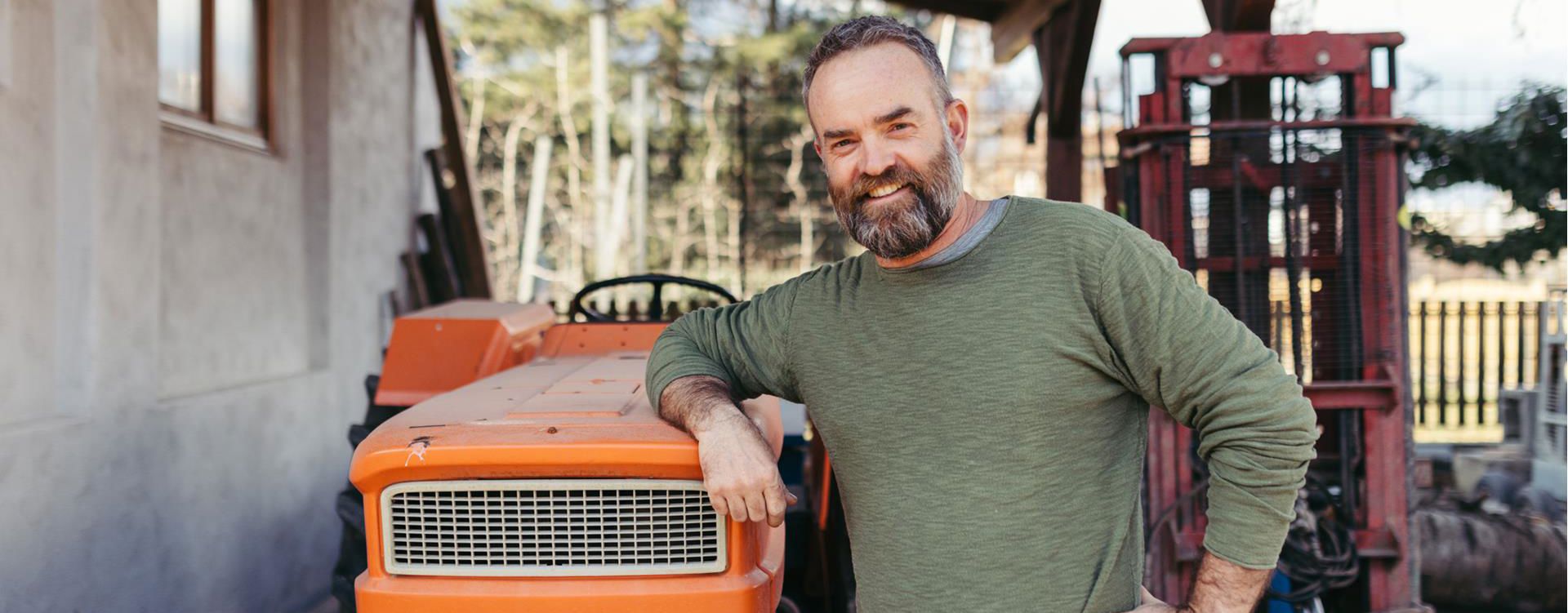
The Reclusive One.
Hannes Felder Marth.
He neither wishes for nor wants crowds of people around him, at least not at work. He enjoys being in the groves, alone with his thoughts. And yet he is more open than people might think after reading these first lines.
read more1
2
3
4


